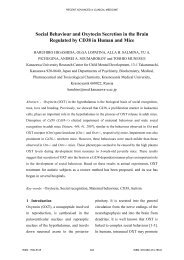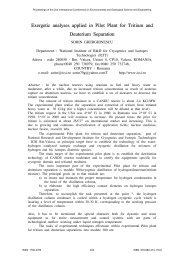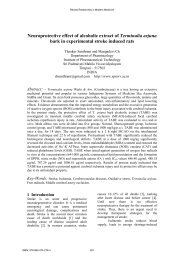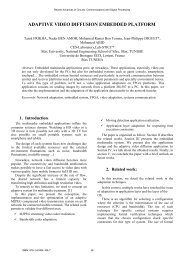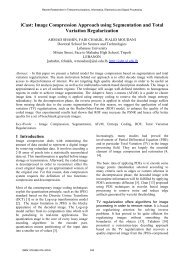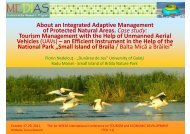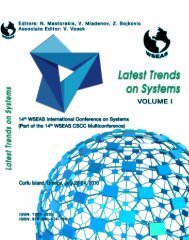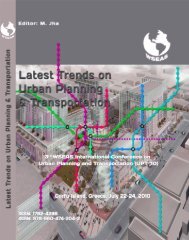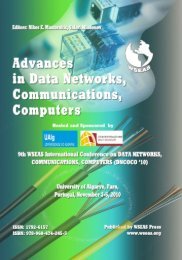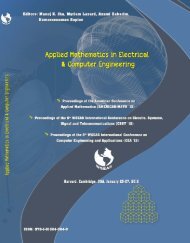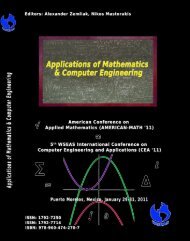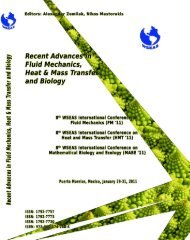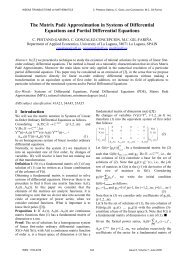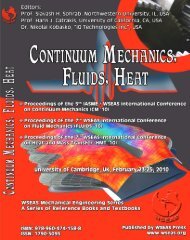COMMUNICATION and MANAGEMENT in - Wseas.us
COMMUNICATION and MANAGEMENT in - Wseas.us
COMMUNICATION and MANAGEMENT in - Wseas.us
You also want an ePaper? Increase the reach of your titles
YUMPU automatically turns print PDFs into web optimized ePapers that Google loves.
<strong>COMMUNICATION</strong> <strong>and</strong><br />
<strong>MANAGEMENT</strong> <strong>in</strong><br />
TECHNOLOGICAL INNOVATION<br />
<strong>and</strong> ACADEMIC GLOBALIZATION<br />
International Conference on Communication <strong>and</strong> Management <strong>in</strong><br />
Technological Innovation <strong>and</strong> Academic Globalization<br />
(COMATIA '10)<br />
Puerto De La Cruz, Tenerife<br />
November 30-December 2, 2010<br />
Published by WSEAS Press ISSN: 1792-6718<br />
www.wseas.org ISBN: 978-960-474-254-7
<strong>COMMUNICATION</strong> <strong>and</strong><br />
<strong>MANAGEMENT</strong> <strong>in</strong><br />
TECHNOLOGICAL INNOVATION<br />
<strong>and</strong> ACADEMIC GLOBALIZATION<br />
International Conference on Communication <strong>and</strong> Management <strong>in</strong><br />
Technological Innovation <strong>and</strong> Academic Globalization<br />
(COMATIA '10)<br />
Puerto De La Cruz, Tenerife, November 30-December 2, 2010<br />
Published by WSEAS Press<br />
www.wseas.org<br />
Copyright © 2010, by WSEAS Press<br />
All the copyright of the present book belongs to the World Scientific <strong>and</strong> Eng<strong>in</strong>eer<strong>in</strong>g Academy <strong>and</strong><br />
Society Press. All rights reserved. No part of this publication may be reproduced, stored <strong>in</strong> a retrieval<br />
system, or transmitted <strong>in</strong> any form or by any means, electronic, mechanical, photocopy<strong>in</strong>g, record<strong>in</strong>g, or<br />
otherwise, without the prior written permission of the Editor of World Scientific <strong>and</strong> Eng<strong>in</strong>eer<strong>in</strong>g Academy<br />
<strong>and</strong> Society Press.<br />
All papers of the present volume were peer reviewed by two <strong>in</strong>dependent reviewers. Acceptance was<br />
granted when both reviewers' recommendations were positive.<br />
See also: http://www.worldses.org/review/<strong>in</strong>dex.html<br />
ISSN: 1792-6718<br />
ISBN: 978-960-474-254-7<br />
Institute for Environment, Eng<strong>in</strong>eer<strong>in</strong>g, Economics <strong>and</strong> Applied Mathematics
<strong>COMMUNICATION</strong> <strong>and</strong><br />
<strong>MANAGEMENT</strong> <strong>in</strong><br />
TECHNOLOGICAL INNOVATION<br />
<strong>and</strong> ACADEMIC GLOBALIZATION<br />
International Conference on Communication <strong>and</strong> Management <strong>in</strong><br />
Technological Innovation <strong>and</strong> Academic Globalization<br />
(COMATIA '10)<br />
Puerto De La Cruz, Tenerife, November 30-December 2, 2010
Editors:<br />
Prof. Valeri Mladenov, Technical University of Sofia, BULGARIA<br />
Prof. Kleanthis Psarris, University of Texas at San Antonio, TX, USA<br />
Prof. Nikos Mastorakis, Technical University of Sofia, BULGARIA<br />
Prof. Amauri Caballero, Florida International University, Miami, FL, USA<br />
Prof. George Vachtsevanos, Georgia Institute of Technology, Atlanta, GA, USA<br />
International Program Committee Members:<br />
Nikos Mastorakis, BULGARIA<br />
Ronald Yager, USA<br />
Amauri Caballero, USA<br />
George Vachtsevanos, USA<br />
Robert F<strong>in</strong>kel, USA<br />
Demetrios Kazakos, USA<br />
Theodore Trafalis, USA<br />
Takis Kasparis, USA<br />
Zhiqiang Gao, USA<br />
Yan Wu, USA<br />
Spyros Tragoudas, USA<br />
Arkady Kholodenko, USA<br />
Gregory Baker, USA<br />
Galigekere Dattatreya, USA<br />
Carol<strong>in</strong>e Sweezy, USA<br />
Asad Salem, USA<br />
Dian Zhou, USA<br />
Met<strong>in</strong> Demiralp, TURKEY<br />
Olga Mart<strong>in</strong>, ROMANIA<br />
Panos Pardalos, USA<br />
Constant<strong>in</strong> Udriste, ROMANIA<br />
Kleanthis Psarris, USA<br />
Andrew D. Jones, USA<br />
Valeri Mladenov, BULGARIA<br />
Neri F., ITALY<br />
Chen S. Y., P. R. CHINA<br />
Shyi-M<strong>in</strong>g Chen, R. O. C.<br />
Yen K., USA<br />
Rong-Jyue Fang, TAIWAN<br />
Argyrios Varonides, USA<br />
Nikolai Kobasko, USA<br />
Xu Anp<strong>in</strong>g, P. R. CHINA<br />
Zhu H., JAPAN
Communication <strong>and</strong> Management <strong>in</strong> Technological Innovation <strong>and</strong> Academic Globalization<br />
Table of Contents<br />
Plenary Lecture 1: Deep <strong>in</strong>sight <strong>in</strong>to the still hidden theory of isoenergetic flow 10<br />
Richard Selescu<br />
Plenary Lecture 2: Neural Network Models for Pattern Recognition <strong>in</strong> Satellite <strong>and</strong> Aerial<br />
Imagery with Environment <strong>and</strong> Defense Applications<br />
Victor-Emil Neagoe<br />
12<br />
Plenary Lecture 3: H<strong>and</strong>-based Biometrics: High Security vs. Low Security 13<br />
Carlos Manuel Travieso Gonzalez<br />
Plenary Lecture 4: Eng<strong>in</strong>eer<strong>in</strong>g Application Software: A Formal Primer 14<br />
Stefan D. Bruda<br />
Plenary Lecture 5: Comb<strong>in</strong><strong>in</strong>g mathematical forecast<strong>in</strong>g with <strong>in</strong>tuitive techniques for better<br />
decision mak<strong>in</strong>g<br />
Raj Siriram<br />
15<br />
Plenary Lecture 6: Volatile Organic Compounds <strong>in</strong> Indoor Environment of Urban India 16<br />
Anjali Srivastava<br />
Plenary Lecture 7: Circuit Analysis to Natural Resources <strong>and</strong> Environmental Economic<br />
Dynamics <strong>and</strong> Control<br />
Andre A. Keller<br />
17<br />
Plenary Lecture 8: The advance experimental <strong>and</strong> numerical studies of water turbulent jets 18<br />
Dan Victor Cavaropol<br />
Plenary Lecture 9: The importance of results dissem<strong>in</strong>ation with<strong>in</strong> mult<strong>in</strong>ational<br />
environmental projects. Case study: Project CIVITAS – SUCCESS<br />
Catal<strong>in</strong> Popescu<br />
19<br />
Plenary Lecture 10: Achiev<strong>in</strong>g the Best Practices <strong>in</strong> Lightn<strong>in</strong>g Protection System 20<br />
Mohd Za<strong>in</strong>al Abid<strong>in</strong> Ab Kadir<br />
Plenary Lecture 11: Controlled stochastic jump processes 21<br />
A. B. Piunovskiy<br />
Plenary Lecture 12: Resonant Absorption of Long Waves By L<strong>in</strong>ear Microstructures 22<br />
Vladimir V. Arabadzhi<br />
Plenary Lecture 13: Build<strong>in</strong>g Awareness <strong>and</strong> Underst<strong>and</strong><strong>in</strong>g of Electrical Ecosystems as<br />
Confluence of Human Technical Applications <strong>and</strong> Earth Natural Systems<br />
Cornelia Aida Bulucea<br />
Plenary Lecture 14: Strategic Alternatives for the Transport Sector <strong>and</strong> Fuel Consumption <strong>in</strong><br />
Brazil<br />
Hugo Ferreira Braga Tadeu<br />
Plenary Lecture 15: The Adoption of eBank<strong>in</strong>g: an Application of Theories <strong>and</strong> Models for<br />
Technologies Acceptance<br />
Liliana Mihaela Moga<br />
23<br />
24<br />
25<br />
ISBN: 978-960-474-254-7 7
Communication <strong>and</strong> Management <strong>in</strong> Technological Innovation <strong>and</strong> Academic Globalization<br />
Plenary Lecture 16: Environment Monitor<strong>in</strong>g Based on Sensor Networks <strong>and</strong> Artificial<br />
Intelligence<br />
Constant<strong>in</strong> Volosencu<br />
Plenary Lecture 17: Current Measurement Trends <strong>in</strong> F<strong>in</strong>ancial Report<strong>in</strong>g: From Historical<br />
Costs towards Fair Value Concept (<strong>and</strong> Back)<br />
Jiri Strouhal<br />
Plenary Lecture 18: Relation between Organizational Culture <strong>and</strong> Work Motivation <strong>in</strong> a<br />
Romanian State University<br />
Cucu-Ciuhan Gean<strong>in</strong>a<br />
26<br />
27<br />
28<br />
Assessment of the Consequences of a Major Accident for the Tank Parks that Store BTX 29<br />
Flor<strong>in</strong>el Lupu, Liviu Toader, Cost<strong>in</strong> Il<strong>in</strong>ca, Catal<strong>in</strong> Popescu<br />
Usability Vers<strong>us</strong> Security of Authentication 34<br />
Miloslav Hub, Jan Capek, Renata Myskova, Radim Roudny<br />
Barriers to Internationalization of B-to-B Services 39<br />
Jukka Ojasalo<br />
Analysis of Regional Innovation Systems by Neural Networks <strong>and</strong> Cl<strong>us</strong>ter Analysis 46<br />
Veronika Hajkova, Petr Hajek<br />
Regional Development <strong>in</strong> Hradec Kralove Region 52<br />
Jaroslav Kovarnik<br />
Petri Nets-Based Models for Basic Authentication Procedure 57<br />
J. Capek, M. Hub, R. Myskova, R. Roudny<br />
Assess<strong>in</strong>g the Relative Effectiveness of Technological Strategies for Fight<strong>in</strong>g Counterfeit<br />
Medic<strong>in</strong>es<br />
Elisabeth Lefebvre, Alej<strong>and</strong>ro Romero, Louis-A. Lefebvre, Carol<strong>in</strong>e Krissi<br />
An Analysis of the Learn<strong>in</strong>g Outcome of the Automatic Dual-Axis Sun Track<strong>in</strong>g Laboratory<br />
for Solar Cell System<br />
Yanawan Kengthanoommar, Narong Mungkung<br />
62<br />
68<br />
Wireless Communication for Sensors 72<br />
Lkhagvatseren T., Hr<strong>us</strong>ka F.<br />
B-PLC Hierarchy Model Approach: Based on ATM Network 78<br />
A. G. Garrido, J. J. J. Medel, G. J. C. Sanchez<br />
Some Aspects Regard<strong>in</strong>g IP <strong>in</strong> Universities (I) 84<br />
D. Savescu<br />
Some Aspects Regard<strong>in</strong>g IP <strong>in</strong> Universities (II) 88<br />
D. Savescu<br />
Management of Indigeno<strong>us</strong> Knowledge for Develop<strong>in</strong>g Countries 94<br />
Saeed Lodhi, Peter Mikulecky<br />
ISBN: 978-960-474-254-7 8
Communication <strong>and</strong> Management <strong>in</strong> Technological Innovation <strong>and</strong> Academic Globalization<br />
Labor Market <strong>and</strong> FDI. Evidence from Romania 99<br />
Crist<strong>in</strong>a Jude, Ovidiu Veres<br />
Knowledge Management Implementation <strong>in</strong> Public Services 104<br />
Mohammad Saeed Lodhi, Peter Mikulecky<br />
M-Commerce <strong>and</strong> M-Bank<strong>in</strong>g Foc<strong>us</strong>ed on Czech Republic 109<br />
Hana Tomaskova<br />
The Use of Mobile ICT Devices <strong>in</strong> Small <strong>and</strong> Medium-Sized Companies <strong>in</strong> the Czech Republic 113<br />
Hana Mohelska<br />
Competencies <strong>and</strong> Onl<strong>in</strong>e Recruit<strong>in</strong>g for Bank<strong>in</strong>g Occupations 117<br />
Vasile Paul Bresfelean, Ovidiu Veres, Cristian Bologa<br />
A Data M<strong>in</strong><strong>in</strong>g Method for Accurate Employment Search on the Web 123<br />
Crist<strong>in</strong>a Ioana Muntean, Darie Moldovan, Ovidiu Veres<br />
Study of Steel Products Distribution Market <strong>in</strong> Pol<strong>and</strong> 129<br />
Dima I. Constant<strong>in</strong>, Beata Sl<strong>us</strong>arczyk, Sebastian Kot, Goldbach Felix Constant<strong>in</strong>, Popescu Olivia<br />
Roxana<br />
Career Aspirations, Goal Orientation <strong>and</strong> Classroom Anxiety 133<br />
Soonthornpathai Chantara, Rav<strong>in</strong>der Koul, Sittichai Kaewkuekool<br />
Datanetwork<strong>in</strong>g Aspects of Power Substation Automation 147<br />
Josef Horalek, Vladimir Sobeslav<br />
Simulation <strong>and</strong> Model<strong>in</strong>g of Packet Loss on Self-Similar VoIP Traffic 154<br />
Homero Toral, Jaime S. Ortegon, Julio C. Ramirez, Leopoldo Estrada<br />
Authors Index 160<br />
ISBN: 978-960-474-254-7 9
Communication <strong>and</strong> Management <strong>in</strong> Technological Innovation <strong>and</strong> Academic Globalization<br />
Plenary Lecture 1<br />
Deep <strong>in</strong>sight <strong>in</strong>to the still hidden theory of isoenergetic flow<br />
Prof. Richard Selescu<br />
Department of Aerodynamics,<br />
“Elie Carafoli” National Institute for Aerospace Research – INCAS<br />
220, Bd. Iuliu Maniu, Code 061126, Sector 6, Bucharest, ROMANIA<br />
Phone: +40 21 434 0083; Fax: +40 21 434 0082;<br />
rselescu@aero.<strong>in</strong>cas.ro web page: http://www.<strong>in</strong>cas.ro<br />
Abstract: The Aim of the Work: This <strong>in</strong>tr<strong>in</strong>sic analytic study was done with the aim of improv<strong>in</strong>g <strong>and</strong> enrich<strong>in</strong>g the<br />
knowledge about the local physical phenomena encountered <strong>in</strong> both fluid mechanics <strong>and</strong> magneto-fluid dynamics,<br />
elaborat<strong>in</strong>g a new physical & mathematical model of fluid flow <strong>and</strong> magnetic field, by <strong>us</strong><strong>in</strong>g a special type of<br />
coord<strong>in</strong>ate system. It cont<strong>in</strong>ues a series of works presented by the author at the 5th WCNA <strong>and</strong> at some WSEAS<br />
conferences <strong>in</strong> 2008, represent<strong>in</strong>g a real deep <strong>in</strong>sight <strong>in</strong>to the still hidden theory of isoenergetic flow, this one be<strong>in</strong>g a<br />
lesser known doma<strong>in</strong> <strong>in</strong> the physical sciences (approach<strong>in</strong>g some new special topics <strong>in</strong> classical potential theory,<br />
fluid mechanics, aerothermodynamics <strong>and</strong> magneto-hydrodynamics, <strong>in</strong>clud<strong>in</strong>g plasma). So far, to the best of the<br />
author’s knowledge, nowhere <strong>in</strong> the world literature a method to obta<strong>in</strong> the general case of first <strong>in</strong>tegrability for the<br />
vector equations of motion has been considered, but very particular cases only. These <strong>in</strong>clude the vector equation of<br />
motion <strong>in</strong> the steady <strong>and</strong> unsteady <strong>in</strong>viscid (or visco<strong>us</strong>) fluid mechanics (D. Bernoulli <strong>and</strong> D. Bernoulli-Lagrange<br />
<strong>in</strong>tegrals), the vector equation of motion <strong>and</strong> the “magnetic <strong>in</strong>duction” one <strong>in</strong> magneto-hydrodynamics, as well as the<br />
system of these two simultaneo<strong>us</strong> vector equations <strong>in</strong> magneto-hydrodynamics. As its title shows, this work is fully<br />
orig<strong>in</strong>al.<br />
Key-Words <strong>and</strong> Phrases: rotational flows, steady <strong>and</strong> unsteady flows, virtual “isentropic” (Bernoulli’s) surfaces,<br />
<strong>in</strong>viscid <strong>and</strong> visco<strong>us</strong> fluids, compressible fluids, flow of an electroconduct<strong>in</strong>g fluid <strong>in</strong> an external magnetic field;<br />
Selescu’s vectors, space curves (vector l<strong>in</strong>es) <strong>and</strong> virtual “zero-work” surfaces<br />
2000 Mathematics Subject Classification: 31 Potential theory; 70 Mechanics of particles <strong>and</strong> systems; 76 Fluid<br />
mechanics; 78 Optics, electromagnetic theory; 80 Classical thermodynamics, heat transfer<br />
Extended Abstract: A model of the isoenergetic flow of an <strong>in</strong>viscid fluid was <strong>in</strong>troduced, <strong>in</strong> order to establish a simpler<br />
form for the general PDE of the velocity potential. It consists ma<strong>in</strong>ly <strong>in</strong> <strong>us</strong><strong>in</strong>g an <strong>in</strong>tr<strong>in</strong>sic system of triorthogonal<br />
curvil<strong>in</strong>ear coord<strong>in</strong>ates (one of them be<strong>in</strong>g tied to the local specific entropy value). The choice of this system enables<br />
the treatment of any 3-D flow (rotational, steady <strong>and</strong> unsteady) as a potential 2-D one, <strong>in</strong>troduc<strong>in</strong>g a 2-D velocity<br />
“quasi-potential”, specific to any isentropic surface. The dependence of the specific entropy on this velocity “quasipotential”<br />
was also established. On the above surfaces the streaml<strong>in</strong>es are orthogonal paths of a family of l<strong>in</strong>es of<br />
equal velocity “quasi-potential”. This model can be extended to some special (but <strong>us</strong>ual) cases <strong>in</strong> magneto-plasma<br />
dynamics (tak<strong>in</strong>g <strong>in</strong>to account the flow vorticity effects, as well as those of the Joule–Lenz heat losses), consider<strong>in</strong>g a<br />
non-isentropic flow of an <strong>in</strong>viscid electroconduct<strong>in</strong>g fluid <strong>in</strong> an external magnetic field. There always are some space<br />
curves along which the motion equation admits a first <strong>in</strong>tegral, mak<strong>in</strong>g evident a new physical quantity – Selescu’s<br />
magneto-hydrodynamic vector $. For a fluid with an <strong>in</strong>f<strong>in</strong>ite electric conductivity (like highly ionized plasma), these<br />
curves are the flow isentropic l<strong>in</strong>es, also enabl<strong>in</strong>g the treatment of any 3-D flow as a “quasi-potential” 2-D one. The<br />
model was extended to the visco<strong>us</strong> Newtonian fluid flows <strong>and</strong> to visco-magnetic flows of conduct<strong>in</strong>g fluids<br />
respectively, <strong>in</strong>troduc<strong>in</strong>g some “zero-work” (for the non-conservative terms) surfaces, some new physical quantities –<br />
Selescu’s vectors (roto-visco<strong>us</strong> S, Si, roto-visco-magnetic §, <strong>and</strong> magnetic Sm), new <strong>in</strong>tr<strong>in</strong>sic coord<strong>in</strong>ate systems,<br />
<strong>and</strong> a 2-D magnetic “quasi-potential”, search<strong>in</strong>g for <strong>and</strong> f<strong>in</strong>d<strong>in</strong>g first <strong>in</strong>tegrals for the motion equation <strong>in</strong> visco<strong>us</strong> fluid<br />
mechanics <strong>and</strong> <strong>in</strong> MHD, <strong>and</strong> for the equation of magnetic <strong>in</strong>duction (separately treated), the last one <strong>in</strong> a similar way<br />
to the vortex equation for a visco<strong>us</strong> Newtonian <strong>in</strong>compressible fluid. The new model was analyzed <strong>in</strong> order to f<strong>in</strong>d a<br />
case of first <strong>in</strong>tegrability <strong>in</strong> MHD for the system of motion <strong>and</strong> magnetic <strong>in</strong>duction simultaneo<strong>us</strong> equations,<br />
establish<strong>in</strong>g a special procedure for f<strong>in</strong>d<strong>in</strong>g such first <strong>in</strong>tegrals. In almost all cases treated, the newly found first<br />
<strong>in</strong>tegrals are similar to D. Bernoulli <strong>and</strong> D. Bernoulli–Lagrange ones, be<strong>in</strong>g obta<strong>in</strong>ed by a procedure for elim<strong>in</strong>at<strong>in</strong>g<br />
the non-conservative terms <strong>in</strong> the respective equations. The PDE of the velocity potential, that of the isentropic<br />
surfaces, as well as those of Selescu’s vector l<strong>in</strong>es <strong>and</strong> zero-work surfaces, were also given.<br />
ISBN: 978-960-474-254-7 10
Communication <strong>and</strong> Management <strong>in</strong> Technological Innovation <strong>and</strong> Academic Globalization<br />
Brief Biography of the Speaker:<br />
Dr.Richard Selescu graduated as an eng<strong>in</strong>eer from the Polytechnic Institute Bucharest, the Faculty of Mechanics,<br />
Department of Aircraft Eng<strong>in</strong>eer<strong>in</strong>g <strong>in</strong> 1970. He is work<strong>in</strong>g <strong>in</strong> the National Institute for Aerospace Research “Elie<br />
Carafoli’’ – INCAS, Department of Aerodynamics, at the Trisonic W<strong>in</strong>d Tunnel Laboratory. He received his PhD<br />
degree <strong>in</strong> Aerodynamics <strong>and</strong> Fluid Mechanics at the Aerospace Eng<strong>in</strong>eer<strong>in</strong>g Faculty of the “Politehnica” University<br />
Bucharest <strong>in</strong> 1999. Among the research fields of <strong>in</strong>terest, he approached the analytic model<strong>in</strong>g <strong>in</strong> aerodynamics, fluid<br />
mechanics <strong>and</strong> magnetofluid dynamics. Th<strong>us</strong>, he <strong>in</strong>troduced the follow<strong>in</strong>g nomenclature: the isentropic surfaces <strong>and</strong><br />
a 2-D velocity quasi-potential function on these surfaces (<strong>in</strong> fluid mechanics); the zero-work surfaces for the nonconservative<br />
terms <strong>in</strong> the motion equation (<strong>in</strong> visco<strong>us</strong> fluid mechanics <strong>and</strong> magnetofluid dynamics); some new<br />
physical quantities – the roto-visco<strong>us</strong> vector (<strong>in</strong> Newtonian visco<strong>us</strong> fluid mechanics), the <strong>in</strong>compressible roto-visco<strong>us</strong><br />
vector (<strong>in</strong> visco<strong>us</strong> <strong>in</strong>compressible fluid mechanics, for the vortex equation), the magneto-hydrodynamic vector (<strong>in</strong><br />
<strong>in</strong>viscid magnetofluid dynamics), the roto-visco-magnetic vector (<strong>in</strong> visco<strong>us</strong> magnetofluid dynamics) <strong>and</strong> the magnetic<br />
vector (<strong>in</strong> visco-magnetic magnetofluid dynamics, for the equation of magnetic <strong>in</strong>duction); a new shock-free<br />
axisymmetric supersonic flow – the tronconical flow (<strong>in</strong> supersonic aerogasdynamics); the similarity depth for<br />
satisfy<strong>in</strong>g the gas-hydrodynamic analogy (<strong>in</strong> supercritical hydrodynamics).<br />
ISBN: 978-960-474-254-7 11
Communication <strong>and</strong> Management <strong>in</strong> Technological Innovation <strong>and</strong> Academic Globalization<br />
Plenary Lecture 2<br />
Neural Network Models for Pattern Recognition <strong>in</strong> Satellite <strong>and</strong> Aerial Imagery with<br />
Environment <strong>and</strong> Defense Applications<br />
Professor Victor-Emil Neagoe<br />
Polytechnic University of Bucharest,<br />
ROMANIA<br />
victoremil@gmail.com<br />
Tel. 0040 721 23 50 20<br />
Abstract: This lecture is an approach dedicated to the improvement <strong>and</strong> experimentation of several neural network<br />
pattern recognition models for satellite <strong>and</strong> aerial imagery. One considers the follow<strong>in</strong>g neural network classifiers:<br />
Multilevel Perceptron (MLP), Radial Basis Function (RBF) neural net, supervised Self-Organiz<strong>in</strong>g Map (SOM), <strong>and</strong><br />
the system of Concurrent Self-Organiz<strong>in</strong>g Maps (CSOM) . CSOM was previo<strong>us</strong>ly proposed by the author of this<br />
lecture ; it is <strong>in</strong> fact a model of Concurrent Neural Classifiers (CNC) , represent<strong>in</strong>g a collection of small neural<br />
networks, which <strong>us</strong>e a global w<strong>in</strong>ner-takes-all strategy. Each neural module is tra<strong>in</strong>ed to correctly classify the patterns<br />
of one class only <strong>and</strong> the number of modules equals the number “M” of classes. One considers the case of choos<strong>in</strong>g<br />
the SOM (Self-Organized-Map) as a neural module. We built “M” tra<strong>in</strong><strong>in</strong>g pattern sets <strong>and</strong> each neural module is<br />
tra<strong>in</strong>ed with the pattern set characterized by the correspond<strong>in</strong>g class label. We have implemented <strong>and</strong> evaluated the<br />
above mentioned neural classifier models for two k<strong>in</strong>d of applications. First application <strong>in</strong>vestigates multispectral<br />
satellite image classification for environment monitor<strong>in</strong>g. The implemented neural classifiers are evaluated <strong>us</strong><strong>in</strong>g a<br />
LANDSAT 7 ETM+ image. One takes <strong>in</strong> consideration both the <strong>in</strong>terb<strong>and</strong> <strong>and</strong> also the <strong>in</strong>trab<strong>and</strong> pixel correlation of<br />
the 7-b<strong>and</strong> image. There is a subset conta<strong>in</strong><strong>in</strong>g labeled pixels, correspond<strong>in</strong>g to several thematic categories: urban<br />
areas, agricultural fields, woods, water, b<strong>us</strong>hes, meadows <strong>and</strong> barren fields. The best experimental result is obta<strong>in</strong>ed<br />
by CSOM model <strong>and</strong> it corresponds to the recognition rate of 99.11 %. Second application evaluates the considered<br />
neural network models for Automated Target Recognition (ATR) based on spot Synthetic Aperture Radar (SAR)<br />
imagery. One <strong>us</strong>es the MSTAR (Mov<strong>in</strong>g <strong>and</strong> Stationary Target Acquisition <strong>and</strong> Recognition) database for three<br />
categories of military vehicles: BMP2 (Tank), BTR 70 (Armored car) <strong>and</strong> T72 (tank). The best performance<br />
corresponds also to the CSOM model <strong>and</strong> it leads to the recognition rate of 95.81%.<br />
Brief Biography of the Speaker:<br />
Dr. Victor-Emil Neagoe is a Professor of the Department of Electronics, Telecommunications, <strong>and</strong> Information<br />
Technology at the Polytechnic University of Bucharest, Romania. He teaches the follow<strong>in</strong>g courses : Pattern<br />
Recognition <strong>and</strong> Artificial Intelligence; Digital Signal Process<strong>in</strong>g; Computational Intelligence ; Detection <strong>and</strong><br />
Estimation for Information Process<strong>in</strong>g. He co-ord<strong>in</strong>ates 10 Ph.D. c<strong>and</strong>idates. His research <strong>in</strong>terest corresponds to the<br />
fields of pattern recognition, computational <strong>in</strong>telligence, biometric technology , satellite image analysis <strong>and</strong> sampl<strong>in</strong>g<br />
theory. Prof. Neagoe is author of more than 120 published papers. His has <strong>in</strong>ternationally recognized results<br />
concern<strong>in</strong>g concurrent self-organized maps, face recognition, satellite image analysis, optimum color conversion,<br />
syntactical self-organized maps, nonuniform sampl<strong>in</strong>g theorems, <strong>in</strong>version of the Van der Monde matrix, predictive<br />
order<strong>in</strong>g <strong>and</strong> l<strong>in</strong>ear approximation for image data compression, Legendre descriptors.<br />
He has been <strong>in</strong>cluded <strong>in</strong> Who’s Who <strong>in</strong> the World <strong>and</strong> Europe 500 <strong>and</strong> he has been nom<strong>in</strong>ated by the American<br />
Biographical Institute for American Medal of Honor <strong>and</strong> for World Medal of Honor. He has been a Member IEEE s<strong>in</strong>ce<br />
1978 <strong>and</strong> a Senior Member IEEE s<strong>in</strong>ce 1984. He has been a plenary speaker for several WSEAS conferences s<strong>in</strong>ce<br />
2006 till 2009.<br />
ISBN: 978-960-474-254-7 12
Communication <strong>and</strong> Management <strong>in</strong> Technological Innovation <strong>and</strong> Academic Globalization<br />
Plenary Lecture 3<br />
H<strong>and</strong>-based Biometrics: High Security vs. Low Security<br />
Professor Carlos Manuel Travieso Gonzalez<br />
Vice-Dean<br />
University of Las Palmas de Gran Canaria<br />
Technological Centre for Innovation <strong>in</strong> Communications (CeTIC)<br />
Higher Technical School of Telecommunications Eng<strong>in</strong>eer<strong>in</strong>g<br />
Camp<strong>us</strong> Universitario de Tafira, s/n<br />
Pabellon B - Despacho 111<br />
35017 - Las Palmas de Gran Canaria, SPAIN.<br />
Phone: +34928452864 / Fax: +34928451243<br />
ctravieso@dsc.ulpgc.es<br />
Abstract: In this Plenary Lecture, will be comment the some biometric approaches <strong>and</strong> its real possibility for its <strong>us</strong>e<br />
on high <strong>and</strong> low security applications. The advances of multimodal biometric systems <strong>and</strong> the new biometric system<br />
allow its <strong>us</strong>e <strong>in</strong> different scenarios. The unions of technology <strong>and</strong> the biometric b<strong>us</strong><strong>in</strong>ess have <strong>in</strong>creased its<br />
expansion. The <strong>us</strong>e of biometric recognition systems has yielded significant progress <strong>in</strong> the last years. However,<br />
considerable advances on both system precision <strong>and</strong> cost reduction of sensors, has not produced an <strong>in</strong>crease <strong>in</strong><br />
<strong>us</strong>er’s confidence, ma<strong>in</strong>ly due to lack of reliability <strong>in</strong> real operational environments, <strong>and</strong> also due to privacy <strong>and</strong><br />
vulnerability concerns. In order to alleviate the problems generated by the adoption of biometric systems, which are <strong>in</strong><br />
any case highly valuable for <strong>in</strong>d<strong>us</strong>trials, the <strong>in</strong>novative development of a biometric scheme is proposed; operat<strong>in</strong>g <strong>in</strong><br />
realistic environments, the system will<br />
<strong>in</strong>corporate the follow<strong>in</strong>g features:<br />
1. Multibiometric, <strong>in</strong>corporat<strong>in</strong>g three different perspectives: multimodal, multi-shot<br />
<strong>and</strong> multi-level.<br />
2. High transparency <strong>and</strong> acceptability, <strong>and</strong> low <strong>in</strong>tr<strong>us</strong>iveness of the adopted<br />
<strong>in</strong>tra-modalities on h<strong>and</strong>-based biometrics, as far as <strong>us</strong>ers accept them as<br />
be<strong>in</strong>g highly transparent, <strong>and</strong> do not require <strong>us</strong>er cooperativeness, nor show<br />
social ref<strong>us</strong>al, as iris or f<strong>in</strong>gerpr<strong>in</strong>ts do.<br />
3. Comb<strong>in</strong>ed <strong>us</strong>e of these <strong>in</strong>tra-modalities <strong>in</strong> order to atta<strong>in</strong> reliability comparable<br />
to iris or f<strong>in</strong>gerpr<strong>in</strong>t modalities.<br />
4. Use of objective quality measures of the test sample, <strong>in</strong> order to weight the<br />
multibiometric f<strong>us</strong>ion process, <strong>in</strong>duc<strong>in</strong>g so an improvement <strong>in</strong> the<br />
authentication rates.<br />
5. Hardware <strong>and</strong> software development oriented to conduct match-on-card tests,<br />
<strong>in</strong> order to improve privacy <strong>and</strong> protection to vulnerability features.<br />
6. Unsupervised database acquisition of the referred biometric traits, produc<strong>in</strong>g<br />
data availability close to operational conditions <strong>in</strong> real environments.<br />
7. Removal of technological dependencies by means of free-code availability.<br />
Brief Biography of the Speaker:<br />
Dr. Carlos M. Travieso-Gonzalez was born <strong>in</strong> Spa<strong>in</strong>. He received the M.Sc. degree <strong>in</strong> 1997 <strong>in</strong> Telecommunication<br />
Eng<strong>in</strong>eer<strong>in</strong>g at Polytechnic University of Catalonia (UPC), Spa<strong>in</strong>. Besides, he received Ph.D. degree <strong>in</strong> 2002 at<br />
University of Las Palmas de Gran Canaria (ULPGC-Spa<strong>in</strong>). He is an Associate Professor from 2001 <strong>in</strong> ULPGC,<br />
teach<strong>in</strong>g subjects on signal process<strong>in</strong>g <strong>and</strong> learn<strong>in</strong>g theory. His research l<strong>in</strong>es are biometric systems, classification<br />
system, medical signal process<strong>in</strong>g, environmental <strong>in</strong>telligence, <strong>and</strong> data m<strong>in</strong><strong>in</strong>g. He has researched <strong>in</strong> 23<br />
International <strong>and</strong> Spanish Research Projects, some of them as head researcher. He has 150 papers published <strong>in</strong><br />
<strong>in</strong>ternational journals <strong>and</strong> conferences. He has been reviewer <strong>in</strong> different <strong>in</strong>ternational journals <strong>and</strong> conferences s<strong>in</strong>ce<br />
2001. He is Image Process<strong>in</strong>g Technical IASTED Committee Member. He is Vice-Dean from 2004 <strong>in</strong> Higher<br />
Technical School of Telecommunication Eng<strong>in</strong>eers <strong>in</strong> ULPGC.<br />
ISBN: 978-960-474-254-7 13
Communication <strong>and</strong> Management <strong>in</strong> Technological Innovation <strong>and</strong> Academic Globalization<br />
Plenary Lecture 4<br />
Eng<strong>in</strong>eer<strong>in</strong>g Application Software: A Formal Primer<br />
Stefan D. Bruda, PhD<br />
Associate Professor of Computer Science<br />
Bishop's University 2600 College St, Sherbrooke, Quebec J1M 1Z7,<br />
CANADA<br />
Phone: (819) 822-9600 x2374, Fax: (819) 822-9661<br />
http://bruda.ca<br />
stefan@bruda.ca<br />
Abstract: Formal methods--be they logical (such as model check<strong>in</strong>g) or algebraic (such as model-based test<strong>in</strong>g)--<br />
have established themselves as ma<strong>in</strong>stream tools for verification <strong>and</strong> validation. Hardware, device drivers, <strong>and</strong><br />
network protocol have all been formally validated <strong>in</strong> vario<strong>us</strong> contexts. Recent Tur<strong>in</strong>g prizes have recognized this<br />
success. When it comes to specify<strong>in</strong>g <strong>and</strong> verify<strong>in</strong>g complex application software, formal methods have hit however a<br />
stumbl<strong>in</strong>g block. Indeed, conformance test<strong>in</strong>g is traditionally based on f<strong>in</strong>ite-state formalisms: a system is at any time<br />
<strong>in</strong> one of the multitude of named states. Such an approach fails for complex software beca<strong>us</strong>e of the sheer number of<br />
necessarily dist<strong>in</strong>ct states (already happen<strong>in</strong>g <strong>in</strong> simpler systems, but becom<strong>in</strong>g simply unmanageable for complex<br />
applications such as word processors or operat<strong>in</strong>g systems). Br<strong>in</strong>g<strong>in</strong>g conformance test<strong>in</strong>g to complex application<br />
software is an emerg<strong>in</strong>g area. Typical programm<strong>in</strong>g languages (<strong>and</strong> th<strong>us</strong> the control flow of software programmed<br />
<strong>us</strong><strong>in</strong>g them) feature nested, recursive <strong>in</strong>vocations of program modules. These features are modelled naturally by<br />
context-free languages. Many non-regular properties are therefore required for software verification. Such properties<br />
generate an f<strong>in</strong>ite state space, which cannot be h<strong>and</strong>led by f<strong>in</strong>ite-state process algebrae or by st<strong>and</strong>ard verification<br />
techniques such as model check<strong>in</strong>g. Context-free process algebrae such as BPA can specify context-free properties.<br />
However, concurrency cannot be provided by context-free process algebrae s<strong>in</strong>ce context-free languages are not<br />
closed under <strong>in</strong>tersection. This talk foc<strong>us</strong>es on the quest of f<strong>in</strong>d<strong>in</strong>g a formalism that is expressive enough to model<br />
the context-free phenomenae from complex software yet allows for a compositional approach to conformance test<strong>in</strong>g.<br />
We start with visibly p<strong>us</strong>hdown languages (VPL), a promis<strong>in</strong>g construct which unfortunately is not suitable for<br />
compositional specification <strong>and</strong> verification. We extend VPL to multiple stacks, obta<strong>in</strong><strong>in</strong>g multi-stack visibly p<strong>us</strong>hdown<br />
languages (MVPL). These languages model concurrency naturally, but their st<strong>and</strong>ard def<strong>in</strong>ition does not allow<br />
compositional approaches. We then present an alternate set of operations over MVPL that are natural <strong>and</strong> also<br />
permit compositional specification <strong>and</strong> verification. The subsequent tools for specify<strong>in</strong>g complex, recursive application<br />
software will also be disc<strong>us</strong>sed.<br />
Brief Biography of the Speaker:<br />
Dr. Stefan D. Bruda is Associate Professor of Computer Science with Bishop's University <strong>in</strong> Sherbrooke, Quebec. He<br />
obta<strong>in</strong>ed his PhD from Queen's University at K<strong>in</strong>gston for his work <strong>in</strong> the area of computational models for parallel<br />
<strong>and</strong> real-time computations. His current research <strong>in</strong>terests rema<strong>in</strong>s mostly <strong>in</strong> the theoretical realm, though they are<br />
now closer to practice be<strong>in</strong>g foc<strong>us</strong>ed primarily on formal software eng<strong>in</strong>eer<strong>in</strong>g (but also on models of computation<br />
<strong>and</strong> formal languages). Dr. Bruda is the author of the book "Reconfiguration is Shared Memory: Collaps<strong>in</strong>g the<br />
Hierarchy of Parallel Models with Reconfigurable B<strong>us</strong>es <strong>and</strong> Shared Memory" (LAP Publish<strong>in</strong>g, 2010) <strong>and</strong> over 40<br />
journal <strong>and</strong> conference papers. He is an editor of Parallel Process<strong>in</strong>g Letters.<br />
http://bruda.ca/ http://part.bruda.ca/papers.html<br />
ISBN: 978-960-474-254-7 14
Communication <strong>and</strong> Management <strong>in</strong> Technological Innovation <strong>and</strong> Academic Globalization<br />
Plenary Lecture 5<br />
Comb<strong>in</strong><strong>in</strong>g mathematical forecast<strong>in</strong>g with <strong>in</strong>tuitive techniques for better decision mak<strong>in</strong>g<br />
Dr Raj Siriram<br />
Chief Information Officer<br />
Centre for B<strong>us</strong><strong>in</strong>ess Innovation <strong>and</strong> Technology Solutions - (C-Bits)<br />
Dimension Data Middle East <strong>and</strong> Africa<br />
SOUTH AFRICA<br />
Tel: 087 365 6702 or +2711 575 6702<br />
Fax: +11 576 6702<br />
Mobile: +2782 894 6253<br />
raj.siriram@mea.dimensiondata.com<br />
Abstract: Mathematical models are <strong>us</strong>ed to forecast new product sales. Forecast<strong>in</strong>g <strong>us</strong><strong>in</strong>g mathematical methods<br />
have been criticized by many researchers, as the forecasts are often not sufficiently accurate to<br />
be applied to b<strong>us</strong><strong>in</strong>ess decisions. Forecast<strong>in</strong>g new product sales may be improved by <strong>us</strong><strong>in</strong>g <strong>in</strong>tuitive techniques. In<br />
this paper <strong>in</strong>tuitive techniques are applied to mathematical forecast<strong>in</strong>g models. A growth curve predication model is<br />
developed; <strong>in</strong> addition a reference data set is <strong>us</strong>ed to validate the outputs, provid<strong>in</strong>g important lessons for managers.<br />
Brief Biography of the Speaker:<br />
Dr. Raj Siriram is Chief Information Officer at Dimension Data Middle East <strong>and</strong> Africa. He has a wide range of<br />
<strong>in</strong>d<strong>us</strong>trial experience from Information technology, profit <strong>and</strong> loss responsibilities <strong>in</strong> high technology environments,<br />
supply cha<strong>in</strong> management, project management, performance management <strong>and</strong> b<strong>us</strong><strong>in</strong>ess eng<strong>in</strong>eer<strong>in</strong>g. His research<br />
<strong>in</strong>terests are <strong>in</strong> technology management <strong>and</strong> systems eng<strong>in</strong>eer<strong>in</strong>g. Raj is a registered Professional Technologist <strong>in</strong><br />
eng<strong>in</strong>eer<strong>in</strong>g. He holds a Ph.D. <strong>in</strong> Ind<strong>us</strong>trial Eng<strong>in</strong>eer<strong>in</strong>g from the University of Witwatersr<strong>and</strong>, In South Africa, School<br />
of Mechanical, Ind<strong>us</strong>trial <strong>and</strong> Aeronautical Eng<strong>in</strong>eer<strong>in</strong>g. He is also a member of the <strong>in</strong>stitute of Directors, South<br />
African Institute of Ind<strong>us</strong>trial Eng<strong>in</strong>eers, Institute of Ind<strong>us</strong>trial Eng<strong>in</strong>eers (US) <strong>and</strong> many other professional bodies.<br />
ISBN: 978-960-474-254-7 15
Communication <strong>and</strong> Management <strong>in</strong> Technological Innovation <strong>and</strong> Academic Globalization<br />
Plenary Lecture 6<br />
Volatile Organic Compounds <strong>in</strong> Indoor Environment of Urban India<br />
Dr. Anjali Srivastava<br />
Deputy Director & Head<br />
Kolkata Zonal Center<br />
East Kolkata Development Project<br />
i-8 Sector C, EM Bye Pass<br />
PO East Kolkata Township<br />
Kolkata 700107<br />
INDIA<br />
anjali54@gmail.com<br />
Abstract: Indoor Air Pollution (IAP) describes the adverse ambient air conditions <strong>in</strong>side ho<strong>us</strong>eholds, schools, places<br />
of work <strong>and</strong> other <strong>in</strong>door spaces. This can be ca<strong>us</strong>ed by a range of sources, <strong>in</strong>clud<strong>in</strong>g stoves, smok<strong>in</strong>g, consumer<br />
products, furnish<strong>in</strong>gs, <strong>in</strong>filteration of outdoor air <strong>and</strong> mach<strong>in</strong>ery etc. Air pollution has become a major concern <strong>in</strong> India<br />
<strong>in</strong> recent years both beca<strong>us</strong>e it is now clear that large parts of the Indian urban population are exposed to some of<br />
the highest pollutant levels <strong>in</strong> the world <strong>and</strong> also beca<strong>us</strong>e new studies around the world on the health effects of air<br />
pollution have <strong>in</strong>creased confidence <strong>in</strong> estimates of the risks posed by air pollution exposures. Most IAP issues<br />
studied <strong>in</strong> the develop<strong>in</strong>g world <strong>in</strong>clud<strong>in</strong>g India foc<strong>us</strong> on comb<strong>us</strong>tion of coal, wood <strong>and</strong> other biomass fuels. Pollutants<br />
foc<strong>us</strong>ed are ma<strong>in</strong>ly PM10 <strong>and</strong> PM 2.5. Very little work has been done on monitor<strong>in</strong>g of VOCs <strong>in</strong> <strong>in</strong>door of Indian<br />
urban cities. Limited studies carried out <strong>in</strong>dicate high levels of VOCs <strong>in</strong> <strong>in</strong>doors. Sufficient data is available to<br />
categorise VOCs as a pollutant warrant<strong>in</strong>g control <strong>in</strong> <strong>in</strong>door environment.<br />
More than forty VOCs have been identified <strong>in</strong> variety of <strong>in</strong>door environment viz residential, food court, theater,<br />
conference hall, library, offices, restaurant, bar, class rooms, bank <strong>and</strong> pr<strong>in</strong>t<strong>in</strong>g press <strong>in</strong> Mumbai <strong>and</strong> Kolkata. One<br />
fourth of these are Hazardo<strong>us</strong> Air Pollutants. The exposure risk <strong>and</strong> Hazard Index has been estimated to be greater<br />
than 1.<br />
Brief Biography of the Speaker:<br />
Dr. Anjali Srivastava is presently work<strong>in</strong>g as Deputy Director <strong>and</strong> Head at National Environmental Eng<strong>in</strong>eer<strong>in</strong>g<br />
Research Institute(NEERI), Kolkata Zonal Centre. She is work<strong>in</strong>g with the Institute for last 20 years. She is M.Sc.<br />
(Master of Science, 1974) <strong>and</strong> Ph.D. <strong>in</strong> Physical Chemistry (1979) from Nagpur University, India <strong>and</strong> was associated<br />
with Nagpur University, Allahabad University <strong>and</strong> Kobe University, Japan (1980-81) as faculty. She has more than<br />
120 publications <strong>in</strong> journals of repute. She is author chapters <strong>in</strong> books. She has represented NEERI <strong>in</strong> number of<br />
regulatory committees. Her key qualifications are air <strong>and</strong> water pollution monitor<strong>in</strong>g <strong>and</strong> modell<strong>in</strong>g, Development of<br />
analytical methods for air <strong>and</strong> water pollution monitor<strong>in</strong>g <strong>and</strong> <strong>in</strong>strumentation development, Environmental Impact<br />
Assessment <strong>and</strong> Audit. She is reviewer of scientific articles for Atmospheric Environment, The Science of Total<br />
Environment, Environment Monitor<strong>in</strong>g <strong>and</strong> Assessment, Environment Modell<strong>in</strong>g <strong>and</strong> Assessment, Journal Hazardo<strong>us</strong><br />
Material <strong>and</strong> others. The Zonal Center caters to the R&D needs related to environment <strong>and</strong> development of Eastern<br />
<strong>and</strong> North Eastern region of India.<br />
ISBN: 978-960-474-254-7 16
Communication <strong>and</strong> Management <strong>in</strong> Technological Innovation <strong>and</strong> Academic Globalization<br />
Plenary Lecture 7<br />
Circuit Analysis to Natural Resources <strong>and</strong> Environmental Economic Dynamics <strong>and</strong><br />
Control<br />
Professor Andre A. Keller<br />
CLERSE- Centre Lillois d’Etudes et de Recherches Sociologiques et Economiques UMR/CNRS<br />
8019<br />
Universite de Lille 1 Sciences et Technologies<br />
Cite Scientifique 59655 Villeneuve d’Ascq Cedex FRANCE<br />
<strong>and</strong>re.keller@univ-lille.fr<br />
Abstract: This study extends to the natural resource <strong>and</strong> environmental economics the <strong>us</strong>e of the conventionalcircuit<br />
analysis <strong>and</strong> control <strong>in</strong> eng<strong>in</strong>eer<strong>in</strong>g. Resources <strong>and</strong> environmental management problemsare <strong>in</strong>vestigated with help<br />
of cont<strong>in</strong>uo<strong>us</strong>-time <strong>and</strong> discrete-time systems: optimal <strong>us</strong>e of natural resources, growth models with pollut<strong>in</strong>g events<br />
<strong>and</strong> fishery models with open-access to the <strong>in</strong>d<strong>us</strong>try. This study <strong>in</strong>troduces the fundamental block-diagram approach,<br />
with small-size applications to natural resources,pollution <strong>and</strong> fisheries management problems. The software<br />
MATHEMATICA (version 7.0.1.0) <strong>and</strong> its application packages are <strong>us</strong>ed for analyz<strong>in</strong>g <strong>and</strong> solv<strong>in</strong>g the systems,<br />
symbolically <strong>and</strong> numerically.<br />
Brief Biography of the Speaker:<br />
At present, Professor Andre A. Keller (66) is an associate researcher <strong>in</strong> mathematical economics with application to<br />
environment problems <strong>and</strong> related model<strong>in</strong>g techniques at the CLERSE a research unit of the French Centre National<br />
de le Recherche Scientifique (CNRS) at the University Lille 1, for Sciences <strong>and</strong> Technologies. Prof. Keller received<br />
his PhD <strong>in</strong> Economics (Operations Research) <strong>in</strong> 1977 from the Universite de Paris. He taught applied mathematics<br />
(l<strong>in</strong>ear <strong>and</strong> nonl<strong>in</strong>ear optimization techniques) <strong>and</strong> econometrics, microeconomics, theory of games <strong>and</strong> dynamic<br />
macroeconomic analysis. S<strong>in</strong>ce 1970, he has been chief econometrician at the Centre d’Observation Economique<br />
of the Chamber of Commerce & Ind<strong>us</strong>try of Paris. His experience <strong>in</strong>cludes acroeconomic, regional studies <strong>and</strong><br />
commercial statistics: build<strong>in</strong>g econometric systems for short run analysis, analyz<strong>in</strong>g policy impacts <strong>and</strong> forecast<strong>in</strong>g,<br />
monthly time-series treatments. At the same time, he contributed to teach<strong>in</strong>g microeconomics with the Universite de<br />
Paris. S<strong>in</strong>ce 1980, he has been Associate Professor at the Universite de Paris <strong>and</strong> Researcher <strong>in</strong> a research unit of<br />
the CNRS. His experience centers are on build<strong>in</strong>g <strong>and</strong> analyz<strong>in</strong>g large scale macro-econometric models, as well as<br />
forecast<strong>in</strong>g. S<strong>in</strong>ce 1985, his research <strong>in</strong>terest has concentrated on high frequency time-series model<strong>in</strong>g with<br />
application to the foreign exchange market : spectral properties of <strong>us</strong>ual filters, automatic selection of ARIMA<br />
models, efficiency tests. S<strong>in</strong>ce 1990, Prof. Keller’s research is centered on discrete mathematics (graph theory),<br />
stochastic differential games <strong>and</strong> tournaments, circuit theory of systems, dynamics <strong>and</strong> optimal control <strong>in</strong> economic<br />
model<strong>in</strong>g under uncerta<strong>in</strong>ties <strong>and</strong> <strong>in</strong> a fuzzy environment. Prof. Andre A. Keller’s publications consist <strong>in</strong> writ<strong>in</strong>g<br />
articles <strong>and</strong> co-author<strong>in</strong>g books. The articles <strong>in</strong> scientific reviews are on model build<strong>in</strong>g with application to<br />
macroeconomics <strong>and</strong> <strong>in</strong>ternational f<strong>in</strong>ance. The books chapters are on semi-reduced forms of econometric models<br />
(Mart<strong>in</strong><strong>us</strong> Nijhoff, 1984), econometrics of technical change (Spr<strong>in</strong>ger <strong>and</strong> IIASA, 1989), advanced time-series<br />
analysis (Woodhead-Faulkner), circuits enumeration <strong>in</strong> digraphs (Spr<strong>in</strong>ger, 2008), stochastic differential games (Nova<br />
Science, 2009), optimal fuzzy control (InTech, 2009), circuit analysis (Nova Science, forthcom<strong>in</strong>g 2010).<br />
ISBN: 978-960-474-254-7 17
Communication <strong>and</strong> Management <strong>in</strong> Technological Innovation <strong>and</strong> Academic Globalization<br />
Plenary Lecture 8<br />
The advance experimental <strong>and</strong> numerical studies of water turbulent jets<br />
Prof.dr.<strong>in</strong>g. Dan Victor Cavaropol<br />
dean of the Fire Eng<strong>in</strong>eer<strong>in</strong>g Faculty,<br />
“Alex<strong>and</strong>ru Ioan Cuza” Police Academy – Fire Officers Faculty,<br />
1A, Privighetorilor Street, sector 1, Bucharest, ROMANIA<br />
cavaropold@gmail.com<br />
Abstract: This Lecture presents recent research <strong>in</strong> the field of free shear flows, especially those of the turbulent jets.<br />
The <strong>in</strong>tervention <strong>in</strong> the ext<strong>in</strong>guish<strong>in</strong>g process <strong>in</strong> the real fire needs more <strong>in</strong>formation about the zones, <strong>and</strong> the splitt<strong>in</strong>g<br />
process, the diameters of the drops formed. The natural scale experiments was carried out , <strong>and</strong> also a numerical<br />
simulation, consider<strong>in</strong>g the <strong>in</strong>stability of a water turbulent jet. These results gives important <strong>in</strong>formation about how<br />
<strong>and</strong> where m<strong>us</strong>t be a firefighter positioned <strong>in</strong> order to ext<strong>in</strong>guish a fire <strong>in</strong> a shorter time, whit a m<strong>in</strong>imum amount of<br />
water.<br />
Brief Biography of the Speaker:<br />
Dan Victor Cavaropol is Professor Dean of the Fire Officers Faculty of Police Academy, Bucharest, Romania. From<br />
2003 to 2007 he was Assistant Professor while from 1999 to 2003<br />
he was Lecturer while from 1995 to 1999 he was a University Assistant<br />
He received his Ph.D. Eng<strong>in</strong>eer<strong>in</strong>g Diploma – Hydraulics <strong>and</strong> Hydrok<strong>in</strong>etics <strong>in</strong> 1999 from<br />
the Technical University of Civil Eng<strong>in</strong>eer<strong>in</strong>g of Bucharest (UTCB), Romania<br />
ISBN: 978-960-474-254-7 18
Communication <strong>and</strong> Management <strong>in</strong> Technological Innovation <strong>and</strong> Academic Globalization<br />
Plenary Lecture 9<br />
The importance of results dissem<strong>in</strong>ation with<strong>in</strong> mult<strong>in</strong>ational environmental projects. Case<br />
study: Project CIVITAS – SUCCESS<br />
Professor Catal<strong>in</strong> Popescu<br />
Department of Management <strong>and</strong> Market<strong>in</strong>g<br />
University of Oil <strong>and</strong> Gas from Ploiesti,<br />
ROMANIA<br />
cpopescu@upg-ploiesti.ro<br />
Abstract: The ma<strong>in</strong> purpose of projects co-f<strong>in</strong>anced by European Community is to enhance the life of European<br />
citizens by implement<strong>in</strong>g measures with immediate or long term effect. One of the ma<strong>in</strong> sectors targeted by the EC<br />
projects is the transport sector. The transport sector plays a critical role <strong>in</strong> modern economies, but the sector also<br />
accounts for an <strong>in</strong>creas<strong>in</strong>g share of energy end <strong>us</strong>e <strong>and</strong> gaseo<strong>us</strong> emissions. In the European Union the proportion of<br />
energy <strong>us</strong>ed by transport accounts for 29%, <strong>in</strong>d<strong>us</strong>try consumes 32%; <strong>and</strong> residential <strong>and</strong> other sectors the rema<strong>in</strong><strong>in</strong>g<br />
39%. L<strong>and</strong> transport accounts for 86% of total EU consumption <strong>in</strong> the transport sector, <strong>and</strong> almost all the energy<br />
<strong>us</strong>ed is <strong>in</strong> the form of oil products. This presents a challeng<strong>in</strong>g problem as regards security <strong>in</strong> energy supply. More<br />
than 80% of EU citizens live <strong>and</strong> work <strong>in</strong> cities, <strong>and</strong> it is here that the environmental problems ca<strong>us</strong>ed by the transport<br />
sector become most acute. Irrational <strong>us</strong>e of energy comb<strong>in</strong>es with environmental degradation, which <strong>in</strong> turn is l<strong>in</strong>ked<br />
to <strong>in</strong>creas<strong>in</strong>g traffic congestion. Program CIVITAS II specifically calls for the <strong>us</strong>e of technologies, which are<br />
developed but not yet ma<strong>in</strong>stream <strong>and</strong> the foc<strong>us</strong> should be on short/medium term alternatives, i.e. <strong>in</strong>novative biofuels<br />
<strong>and</strong> natural gas, <strong>in</strong>clud<strong>in</strong>g hybrid vehicles that <strong>us</strong>e these fuels. SUCCESS (Smaller Urban Communities <strong>in</strong><br />
CIVITAS for Environmentally S<strong>us</strong>ta<strong>in</strong>able Solutions) contributed to the implementation of many of the EU's policies,<br />
especially environment, energy <strong>and</strong> transport. It also answers to vario<strong>us</strong> questions of European wide <strong>in</strong>terest <strong>and</strong> of<br />
strategic importance.<br />
Brief Biography of the Speaker:<br />
Dr. Catal<strong>in</strong> Popescu is Professor of Management at University of Oil <strong>and</strong> Gas from Ploiesti, Romania. His research<br />
<strong>and</strong> consult<strong>in</strong>g <strong>in</strong>terest <strong>in</strong>clude general management, project management, quantitative methods for b<strong>us</strong><strong>in</strong>ess <strong>and</strong><br />
management, human resource management, eng<strong>in</strong>eer<strong>in</strong>g management, operations management <strong>and</strong> management<br />
<strong>in</strong>formation systems. He received <strong>in</strong> 1991 a degree <strong>in</strong> Eng<strong>in</strong>eer<strong>in</strong>g, a degree <strong>in</strong> Management (2000) <strong>and</strong> a PhD<br />
(2001) <strong>in</strong> Automated Systems concern Model<strong>in</strong>g <strong>and</strong> simulation of production systems, from the University of Oil <strong>and</strong><br />
Gas from Ploiesti, Romania. Dr. Popescu has published over 125 articles <strong>and</strong> conference papers, 7 books <strong>and</strong> he<br />
was <strong>in</strong>volved <strong>in</strong> more than 19 scientific research grants <strong>and</strong> <strong>in</strong>ternational projects. He is member of AMIER<br />
(Managers <strong>and</strong> Economical Eng<strong>in</strong>eers Association from Romania), COLEAD (International Research Society <strong>in</strong><br />
Leadership <strong>and</strong> Organizational Culture), EURAM (European Academy of Management), IBIMA (International<br />
B<strong>us</strong><strong>in</strong>ess Information Management Association) <strong>and</strong> IMTA Alumni Association (International Management Teachers<br />
Academy) from Slovenia. His <strong>in</strong>ternational experience <strong>in</strong>cludes presentations <strong>and</strong> participation with papers <strong>in</strong> many<br />
places all over the world, <strong>in</strong> more than 20 countries. On the other h<strong>and</strong>, Dr. Catal<strong>in</strong> Popescu is now Vicedean of<br />
Economics Faculty with<strong>in</strong> University of Oil <strong>and</strong> Gas from Ploiesti, Romania. Dr. Popescu is assessor <strong>in</strong> many<br />
academic <strong>and</strong> scientific organizations such as: WSEAS (World Scientific <strong>and</strong> Eng<strong>in</strong>eer<strong>in</strong>g Academy <strong>and</strong> Society),<br />
ANCS (National Agency for Scientific Reasearch for the european projects under POS – CCE competition) <strong>and</strong><br />
ARACIS (Romanian Agency for Quality Assurance <strong>in</strong> High Education) for the doma<strong>in</strong>: Eng<strong>in</strong>eer<strong>in</strong>g <strong>and</strong> Management.<br />
ISBN: 978-960-474-254-7 19
Communication <strong>and</strong> Management <strong>in</strong> Technological Innovation <strong>and</strong> Academic Globalization<br />
Plenary Lecture 10<br />
Achiev<strong>in</strong>g the Best Practices <strong>in</strong> Lightn<strong>in</strong>g Protection System<br />
Senior Lecturer, Dr.Mohd Za<strong>in</strong>al Abid<strong>in</strong> Ab Kadir, PhD, MIEEE<br />
Centre of Excellence on Lightn<strong>in</strong>g Protection (CELP),<br />
Dept. of Electrical <strong>and</strong> Electronics Eng<strong>in</strong>eer<strong>in</strong>g,<br />
Faculty of Eng<strong>in</strong>eer<strong>in</strong>g,<br />
UPM, Selangor, MALAYSIA<br />
mza<strong>in</strong>al@eng.upm.edu.my<br />
Abstract: There are 2000 thunderstorms <strong>in</strong> progress at any time result<strong>in</strong>g <strong>in</strong> 100 lightn<strong>in</strong>g flashes to ground per<br />
second; this is 8 million per day. It ca<strong>us</strong>es of 24000 lightn<strong>in</strong>g deaths <strong>and</strong> other 240000 are <strong>in</strong>jured per year. These<br />
data proves the critical needs for lightn<strong>in</strong>g protection system. In general, there are a lot of issues with regards to the<br />
selection of proper lightn<strong>in</strong>g protection systems. From the time of the first <strong>in</strong>stallation to the present day,<br />
characterization of the effectiveness rema<strong>in</strong>s a recurr<strong>in</strong>g question. S<strong>us</strong>ta<strong>in</strong>ability is an important criterion <strong>in</strong> ensur<strong>in</strong>g<br />
the chosen protection system is governed by the <strong>in</strong>ternational st<strong>and</strong>ards <strong>and</strong> of course technically <strong>and</strong> scientifically<br />
proven <strong>in</strong> effectiveness. The development of lightn<strong>in</strong>g protection pr<strong>in</strong>ciple throughout the world is based on solid<br />
science. Any scientific method can be summed up after the theory is formed, tested <strong>and</strong> concl<strong>us</strong>ion is drawn. For the<br />
past 250 years, the lightn<strong>in</strong>g protection systems have been <strong>in</strong>tensively studied <strong>and</strong> have been proven effectively<br />
many times. Field data recorded provides provide concl<strong>us</strong>ive evidence that conventional lightn<strong>in</strong>g protection systems<br />
can provide substantial reduction <strong>in</strong> lightn<strong>in</strong>g-related <strong>in</strong>cidents. The data clearly demonstrates the validity of the basic<br />
technology when the requirements are properly applied <strong>and</strong> adequately ma<strong>in</strong>ta<strong>in</strong>ed. Therefore, the questions of what,<br />
why, when, where <strong>and</strong> how are rema<strong>in</strong>s valid towards achiev<strong>in</strong>g the best practice <strong>in</strong> lightn<strong>in</strong>g protection system.<br />
Brief Biography of the Speaker:<br />
Dr. M. Z. A. Ab Kadir graduated with B.Eng degree <strong>in</strong> Electrical <strong>and</strong> Electronic from Universiti Putra Malaysia <strong>in</strong> 2000<br />
<strong>and</strong> obta<strong>in</strong>ed his Ph.D from the University of Manchester, United K<strong>in</strong>gdom <strong>in</strong> 2006 <strong>in</strong> High Voltage Eng<strong>in</strong>eer<strong>in</strong>g.<br />
Currently, he is a Senior Lecturer <strong>in</strong> the Department of Electrical <strong>and</strong> Electronic Eng<strong>in</strong>eer<strong>in</strong>g, Faculty of Eng<strong>in</strong>eer<strong>in</strong>g,<br />
Universiti Putra Malaysia. To date he has authored <strong>and</strong> co-authored over 50 technical papers compris<strong>in</strong>g of national<br />
<strong>and</strong> <strong>in</strong>ternational conferences proceed<strong>in</strong>gs <strong>and</strong> citation <strong>in</strong>dexed journals, as well as owned a patent for his SPD<br />
design. His research <strong>in</strong>terests <strong>in</strong>clude high voltage eng<strong>in</strong>eer<strong>in</strong>g, <strong>in</strong>sulation coord<strong>in</strong>ation, lightn<strong>in</strong>g protection, lightn<strong>in</strong>g<br />
<strong>in</strong>jury analysis <strong>and</strong> power system transients. Dr. Ab Kadir actively <strong>in</strong>volved <strong>in</strong> the professional activities <strong>and</strong> currently<br />
is an IEEE Member (PES, EMC, Insulation <strong>and</strong> Dielectric Societies), Member of AGU, Member of IAENG, Member of<br />
Malaysia Energy Centre (PTM), Ex- Comm. IEEE Malaysia Section, Ex-Comm. IEEE PES Chapter, Work<strong>in</strong>g Group<br />
Member of IEEE PES Lightn<strong>in</strong>g Performance on Overhead L<strong>in</strong>es <strong>and</strong> also the Chairman/Director of Centre of<br />
Excellence on Lightn<strong>in</strong>g Protection (CELP), based <strong>in</strong> Universiti Putra Malaysia (UPM).<br />
ISBN: 978-960-474-254-7 20
Communication <strong>and</strong> Management <strong>in</strong> Technological Innovation <strong>and</strong> Academic Globalization<br />
Plenary Lecture 11<br />
Controlled stochastic jump processes<br />
Dr. A.B.Piunovskiy<br />
Dept. of Mathem. Sciences,<br />
The University of Liverpool, Peach St.,<br />
Liverpool L69 7ZL, UK<br />
Phone: +44-151-7944737 Fax: +44-151-7944754<br />
E-mail: piunov@liv.ac.uk<br />
http://www.maths.liv.ac.uk/ piunov<br />
Abstract: Such processes are widely <strong>us</strong>ed <strong>in</strong> Eng<strong>in</strong>eer<strong>in</strong>g Sciences, Biology, Insurance, Inventory Theory <strong>and</strong> so on.<br />
After describ<strong>in</strong>g mathematical models, we shall present a series of mean<strong>in</strong>gful examples. One of the most powerful<br />
methods of obta<strong>in</strong><strong>in</strong>g an optimal control strategy is Dynamic Programm<strong>in</strong>g. Another modern method of attack is so<br />
called Convex Analytic Approach. In this lecture the both methods will be briefly disc<strong>us</strong>sed. The second half of the<br />
lecture will be devoted to more special models. First, we concentrate on the processes with local transitions, like<br />
birth-<strong>and</strong>-death processes. They are known to be successfully approximated by determ<strong>in</strong>istic differential equations<br />
under so called ”fluid scal<strong>in</strong>g”. New results on the accuracy of such approximation will be presented. Secondly, a new<br />
look at the well known ”C-mu-rule”<br />
<strong>in</strong> the Queu<strong>in</strong>g Theory will be disc<strong>us</strong>sed: we shall compare the stochastic <strong>and</strong> determ<strong>in</strong>istic versions. F<strong>in</strong>ally, we shall<br />
stop on applications of the theory to the optimal buffer siz<strong>in</strong>g for Internet routers. The last several m<strong>in</strong>utes will be<br />
devoted to more general models, open questions <strong>and</strong> new challendg<strong>in</strong>g real life problems.<br />
Brief Biography of the Speaker:<br />
Dr. A.Piunovskiy was born <strong>in</strong> Moscow, R<strong>us</strong>sia, <strong>in</strong> 1954. He graduated from the Moscow Institute of Electronic<br />
Technology (MIEM) with degrees <strong>in</strong> Electrical Eng<strong>in</strong>eer<strong>in</strong>g <strong>and</strong> Applied Mathematics, <strong>and</strong> supported the PhD thesis <strong>in</strong><br />
1981. Dr.A.Piunovskiy worked <strong>in</strong> MIEM <strong>and</strong> IFTP (Moscow State Inst. of Physics <strong>and</strong> Technology). In 1999 he<br />
received the Doctor of Science degree <strong>in</strong> Applied Mathematics. S<strong>in</strong>ce Feb. 2000, he is with Dept. of Mathem.<br />
Sciences, the University of Liverpool, currently hold<strong>in</strong>g the post of Reader. Research <strong>in</strong>terests <strong>in</strong>clude Optimal control<br />
of dynamical systems, Controlled r<strong>and</strong>om processes; Constra<strong>in</strong>ed problems of optimal control; Approximations to<br />
controlled r<strong>and</strong>om processes <strong>and</strong> their accuracy; Computer simulation; Application to optimization problems <strong>in</strong><br />
Operational Research, <strong>in</strong> Technical Systems, <strong>in</strong> Reliability Theory, Queu<strong>in</strong>g Theory, Teletraffic, F<strong>in</strong>ances,<br />
Economics, Ecology, <strong>and</strong> Epidemiology. Dr. A.Piunovskiy received multiple grants from the R<strong>us</strong>sian Fund for Basic<br />
Research, London Mathematical Society, the Royal Society, EPSRC <strong>and</strong> so on. He published more than 80 works,<br />
<strong>in</strong>clud<strong>in</strong>g a textbook <strong>and</strong> a scientific monograph. Another monograph is <strong>in</strong> preparation.<br />
ISBN: 978-960-474-254-7 21
Communication <strong>and</strong> Management <strong>in</strong> Technological Innovation <strong>and</strong> Academic Globalization<br />
Plenary Lecture 12<br />
Resonant Absorption of Long Waves By L<strong>in</strong>ear Microstructures<br />
Dr. Vladimir V. Arabadzhi<br />
Inst Applied Physics R<strong>us</strong>sian<br />
Aca Sci Ulianov st 46 Nizhny<br />
Novgorod 603950.<br />
RUSSIA<br />
Fax: 7-(831)-436-59-76,<br />
E-mail: v.arab@hydro.appl.sci-nnov.ru<br />
Abstract: The effect of resonant absorption of long waves by the oscillator of little gabarits is <strong>in</strong>vestigated analytically<br />
<strong>and</strong> numerically. This effect means that absorption cross-section of the oscillator (monopole, dipole...) is def<strong>in</strong>ed by<br />
wavelength absorbed only, <strong>and</strong> does not depend on wave dimensions (much smaller, than the wavelength absorbed)<br />
of the oscillator. The expression of optimum amplitudes of excitation of the group of degrees of freedom (or<br />
oscillators) <strong>in</strong> the boundary problem of general type is obta<strong>in</strong>ed <strong>in</strong> the form of generalized velocities <strong>and</strong> generalized<br />
forces. Us<strong>in</strong>g the l<strong>in</strong>ear microstructures (formed by monopoles, which are located on the axis periodically) we<br />
<strong>in</strong>vestigated the possibility to achieve the maximum absorption cross-section of the aco<strong>us</strong>tic waves by these<br />
microstructures of small wave dimensions. We consider the examples of l<strong>in</strong>ear microstructures, which provide<br />
unlimited logarithmic, l<strong>in</strong>ear <strong>and</strong> square grow<strong>in</strong>g of the total absorption cross-section, with grow<strong>in</strong>g of the quantity of<br />
elements (monopoles) <strong>in</strong> the l<strong>in</strong>ear microstructure with wave dimensions rema<strong>in</strong><strong>in</strong>g small. The examples of<br />
cooperative <strong>and</strong> the <strong>in</strong>dividual strategies of absorb<strong>in</strong>g oscillators are compared too. The results obta<strong>in</strong>ed can be <strong>us</strong>ed<br />
for another waves: for electromagnetic waves, water surface waves, waves of bend<strong>in</strong>g <strong>in</strong> elastic plates, etc.<br />
Brief Biography of the Speaker:<br />
ARABADZHI VLADIMIR VSEVOLODOVICH, physicist, researcher; born M<strong>in</strong>sk, Belar<strong>us</strong>, Apr. 22, 1956; s. Vsevolod<br />
Isidorovich Arabadzhi <strong>and</strong> Valent<strong>in</strong>a Ivanovna Arabadzhi; m. Olga Alexeevna Vasil’eva, Aug. 11, 1979; child, Ludmila<br />
Vladimirovna. BS, Gorky State U., R<strong>us</strong>sia, 1978, PhD <strong>in</strong> Radiophysics, 1994. Engr. Radiophys. Inst., Nizhny<br />
Novgorod, R<strong>us</strong>sia, 1978-81; with Inst. Applied Physics, R<strong>us</strong>sian Acad. Sci., Nizhny Novgorod, R<strong>us</strong>sia, 1981-94, sr.<br />
scientist, 1994-. Contbr. Articles to profl. Jours. Achivements <strong>in</strong>clude <strong>in</strong>ventions <strong>in</strong> active wave control. Area of<br />
<strong>in</strong>terests: wave thr<strong>us</strong>t, reduc<strong>in</strong>g of aco<strong>us</strong>tical <strong>and</strong> radio visibility of physical bodies.<br />
ISBN: 978-960-474-254-7 22
Communication <strong>and</strong> Management <strong>in</strong> Technological Innovation <strong>and</strong> Academic Globalization<br />
Plenary Lecture 13<br />
Build<strong>in</strong>g Awareness <strong>and</strong> Underst<strong>and</strong><strong>in</strong>g of Electrical Ecosystems as Confluence of Human<br />
Technical Applications <strong>and</strong> Earth Natural Systems<br />
Prof. Cornelia Aida Bulucea<br />
Electrical Mach<strong>in</strong>es <strong>and</strong> Environmental Eng<strong>in</strong>eer<strong>in</strong>g Department<br />
Faculty of Electromechanical <strong>and</strong> Environmental Eng<strong>in</strong>eer<strong>in</strong>g<br />
University of Craiova<br />
ROMANIA<br />
abulucea@gmail.com<br />
Abstract: The foc<strong>us</strong> of this presentation is to enhance the way of th<strong>in</strong>k<strong>in</strong>g that human activities cannot be separated<br />
from the function<strong>in</strong>g of the entire system on Earth. Learn<strong>in</strong>g from the Nature means to accept that the technical<br />
systems processes <strong>in</strong>volv<strong>in</strong>g energy conversion <strong>and</strong> matter transformation need to be l<strong>in</strong>ked to environment<br />
eng<strong>in</strong>eer<strong>in</strong>g. An approach with<strong>in</strong> the Ind<strong>us</strong>trial Ecology framework of technical systems (created by humans) <strong>and</strong><br />
ecological systems (created by Nature) as parts of the same system, the <strong>in</strong>d<strong>us</strong>trial ecosystems, could provide a<br />
holistic view of the <strong>in</strong>teractions <strong>and</strong> symbiosis <strong>in</strong>terrelationships among human activities, <strong>in</strong>d<strong>us</strong>trial practices <strong>and</strong><br />
ecological processes. Although Science not clarified <strong>and</strong> unified technical <strong>and</strong> ecological viewpo<strong>in</strong>ts, a set of<br />
conditions for the performance of s<strong>us</strong>ta<strong>in</strong>able electrical systems should be formulated. This presentation goes on to<br />
adopt a dualist view, <strong>in</strong>corporat<strong>in</strong>g technical <strong>and</strong> environmental dimensions, to describe exergy applicability to<br />
electrical ecosystems. Draw<strong>in</strong>g up a description of the electric system as an <strong>in</strong>d<strong>us</strong>trial ecosystem, with its limits <strong>and</strong><br />
components, def<strong>in</strong><strong>in</strong>g the systems operation regimes <strong>and</strong> assess<strong>in</strong>g the equilibrium po<strong>in</strong>ts of the system with<strong>in</strong> the<br />
two reference frames represent the appropriate steps of the <strong>in</strong>d<strong>us</strong>trial ecosystem metabolism analysis.<br />
Brief Biography of the Speaker:<br />
Cornelia Aida Bulucea is currently an Associate Professor <strong>in</strong> Electrotechnics, Electrical Mach<strong>in</strong>es <strong>and</strong> Environment<br />
Electrical Equipments <strong>in</strong> the Faculty of Electromechanical <strong>and</strong> Environmental Eng<strong>in</strong>eer<strong>in</strong>g, University of Craiova,<br />
Romania. She is graduate from the Faculty of Electrical Eng<strong>in</strong>eer<strong>in</strong>g Craiova <strong>and</strong> she received the Ph.D degree from<br />
Bucharest Polytechnic Institute. In Publish<strong>in</strong>g Ho<strong>us</strong>e she is author of four books <strong>in</strong> electrical eng<strong>in</strong>eer<strong>in</strong>g area.<br />
Research work is foc<strong>us</strong>ed on improved solutions for electrical networks on basis of new electric equipments <strong>and</strong><br />
environmental impact of energy <strong>and</strong> electric transportation systems. She has extensive experience <strong>in</strong> both<br />
experimental <strong>and</strong> theoretical research work, certified by over 70 journal <strong>and</strong> conference research papers <strong>and</strong> 15<br />
research projects from <strong>in</strong>d<strong>us</strong>try. She has held <strong>in</strong> the Association for Environment Protection OLTENIA <strong>and</strong> she is a<br />
regular <strong>in</strong>vited keynote lecture for environmental eng<strong>in</strong>eer<strong>in</strong>g symposia organized by Chamber of Commerce <strong>and</strong><br />
Ind<strong>us</strong>try OLTENIA. Due to WSEAS recognition as huge scientific Forum she participated <strong>in</strong> seven WSEAS<br />
International Conferences, present<strong>in</strong>g papers <strong>and</strong> chair<strong>in</strong>g sessions. She was Plenary Lecturer <strong>in</strong> the 9th<br />
WSEAS/IASME International Conference on ELECTRIC POWER SYSTEMS, HIGH VOLTAGES, ELECTRIC<br />
MACHINES (POWER’09), held by the University of Genova, Genova, Italy, October 17-19, 2009, <strong>in</strong> the 4th<br />
IASME/WSEAS International Conference on ENERGY&ENVIRONMENT (EE’09), ), held by the University of<br />
Cambridge, Cambridge UK, February 24-26, 2009 <strong>and</strong> <strong>in</strong> the 8th WSEAS International Conference on POWER<br />
SYSTEMS (PS’08), held by the University of Cantabria, Sant<strong>and</strong>er, Spa<strong>in</strong>, September 23-25, 2008. She is very proud<br />
by her over 20 papers published <strong>in</strong> the WSEAS Conferences Books <strong>and</strong> 7 papers published <strong>in</strong> WSEAS<br />
TRANSACTIONS ON ENVIRONMENT AND DEVELOPMENT, WSEAS TRANSACTIONS ON CIRCUITS AND<br />
SYSTEMS <strong>and</strong> WSEAS TRANSACTIONS ON ADVANCES IN ENGINEERING EDUCATION.<br />
ISBN: 978-960-474-254-7 23
Communication <strong>and</strong> Management <strong>in</strong> Technological Innovation <strong>and</strong> Academic Globalization<br />
Plenary Lecture 14<br />
Strategic Alternatives for the Transport Sector <strong>and</strong> Fuel Consumption <strong>in</strong> Brazil<br />
Professor Hugo Ferreira Braga Tadeu.<br />
Professor of Supply Cha<strong>in</strong> Management <strong>and</strong> Operations Research for<br />
graduate <strong>and</strong> specialization programas <strong>in</strong> Catholic University,<br />
Fundacao Joao P<strong>in</strong>heiro e Fundacao Dom Cabral<br />
BRAZIL<br />
hugofbraga@gmail.com<br />
Abstract: This work proceeds a study of the national transport sector, for the fuel consumption <strong>and</strong> possible<br />
alternatives for the long term, <strong>in</strong> relation to the adoption of the Monte Carlo Model simulation. Through data collection<br />
<strong>and</strong> the selection criteria related to the problem are proposals <strong>and</strong> optimized objective functions, aim<strong>in</strong>g to maximize<br />
<strong>and</strong> m<strong>in</strong>imize the National GDP <strong>and</strong> the GDP of Transportation. Certa<strong>in</strong> restrictions apply, <strong>in</strong>volv<strong>in</strong>g road, rail, sea,<br />
air, dem<strong>and</strong> vers<strong>us</strong> fuel consumption <strong>and</strong> implicit economical variables, all <strong>in</strong> an optimal condition. Based on the<br />
obta<strong>in</strong>ed results, the <strong>in</strong>fluence of each constra<strong>in</strong>t <strong>in</strong> the objective functions are analyzed, seek<strong>in</strong>g the best scenarios<br />
<strong>and</strong> long-term strategies. Through sensitivity analysis, whose visualization is made possible by the <strong>us</strong>e of l<strong>in</strong>ear<br />
programm<strong>in</strong>g methods <strong>and</strong> computer systems available look for <strong>and</strong> reveal trends of the array for transport <strong>and</strong><br />
dom<strong>in</strong>ant energy source. Therefore, data analyses, obta<strong>in</strong><strong>in</strong>g results from the simulation models, are revealed<br />
essentially to clarify the long-term behavior for different values of the mathematical model proposal.<br />
Brief Biography of the Speaker:<br />
Hugo Ferreira Braga Tadeu is professor of Supply Cha<strong>in</strong> Management <strong>and</strong> Operations Research for graduate <strong>and</strong><br />
specialization programs <strong>in</strong> <strong>in</strong> Catholic University, Fundacao Joao P<strong>in</strong>heiro e Fundacao Dom Cabral. He holds a BSc<br />
from Ibmec B<strong>us</strong><strong>in</strong>ess School, MSc <strong>in</strong> Electrical Eng<strong>in</strong>eer<strong>in</strong>g <strong>and</strong> DsC <strong>in</strong> Mechanical Eng<strong>in</strong>eer<strong>in</strong>g from Catholic<br />
University, Brazil. He published over 82 op<strong>in</strong>ion papers, 16 referred journal papers <strong>in</strong> the areas of supply cha<strong>in</strong><br />
management <strong>and</strong> operations research <strong>and</strong> two books <strong>in</strong> the same area. He writes articles for <strong>in</strong>fluentials newspapers<br />
<strong>in</strong> Brazil, like O Tempo <strong>and</strong> Estado de M<strong>in</strong>as. Hugo Tadeu speaks regularly on the subject of logistics <strong>and</strong> work<strong>in</strong>g<br />
with many <strong>in</strong>ternational firms. He is a reviewer for the European Journal of Operations Research, Revista Mundo<br />
Logistica <strong>and</strong> among others <strong>in</strong> Brazil. He is partner of IELOG (Instituto de Estudos em Logistica), a logistic group <strong>in</strong><br />
Brazil <strong>and</strong> works with Instituto Millenium, a liberal th<strong>in</strong>k tank. Research <strong>in</strong>terests: supply cha<strong>in</strong> management,<br />
logistics, stocks <strong>and</strong> operations research.<br />
ISBN: 978-960-474-254-7 24
Communication <strong>and</strong> Management <strong>in</strong> Technological Innovation <strong>and</strong> Academic Globalization<br />
Plenary Lecture 15<br />
The Adoption of eBank<strong>in</strong>g: an Application of Theories <strong>and</strong> Models for Technologies<br />
Acceptance<br />
Associate Professor Liliana Mihaela Moga<br />
Faculty of Economics<br />
Department of F<strong>in</strong>ance <strong>and</strong> Economic Efficiency<br />
Dunarea de Jos University, Galati, ROMANIA<br />
liliana.moga@gmail.com<br />
Abstract: In an ever-develop<strong>in</strong>g society, a strong, viable economy is vital for any country that seeks to survive on the<br />
global market <strong>and</strong> to provide upwardly liv<strong>in</strong>g st<strong>and</strong>ards for its citizens. Recogniz<strong>in</strong>g the above mentioned po<strong>in</strong>ts as<br />
m<strong>and</strong>atory, Romania is tak<strong>in</strong>g steps to develop its electronic bank<strong>in</strong>g services to meet 21st century global st<strong>and</strong>ards.<br />
The eBank<strong>in</strong>g services ga<strong>in</strong>ed the attention of a major part of the traditional bank<strong>in</strong>g services c<strong>us</strong>tomer beca<strong>us</strong>e of<br />
the great importance of the f<strong>in</strong>ancial activities with<strong>in</strong> the daily life. This m<strong>us</strong>t be a pl<strong>us</strong> for the bank, but this<br />
hypothesis is not confirmed by the real life. The paper identifies the factors that <strong>in</strong>fluence the c<strong>us</strong>tomers’ <strong>in</strong>tention to<br />
<strong>us</strong>e the electronic version for bank<strong>in</strong>g services . The <strong>us</strong>er acceptance of Internet as new technologies that transform<br />
some traditional services <strong>and</strong> activities is a topic of <strong>in</strong>terest for many professionals <strong>and</strong> researchers work<strong>in</strong>g <strong>in</strong><br />
vario<strong>us</strong> doma<strong>in</strong>s. This paper presents the ma<strong>in</strong> theories employed <strong>in</strong> assess<strong>in</strong>g the technology acceptance (theory of<br />
reasoned action, theory of planned behavior) as well as the technology acceptance models that have been developed<br />
on the basis of these theories. The foc<strong>us</strong> of the paper is on the model develops <strong>and</strong>, implicitly, on the hypotheses that<br />
have to be tested <strong>in</strong> order to validate a model for the Internet acceptance <strong>in</strong> traditional bank<strong>in</strong>g services, based both<br />
on the content of the ma<strong>in</strong> theories employed <strong>in</strong> assess<strong>in</strong>g the technology acceptance as Information Diff<strong>us</strong>ion<br />
Theory, Tr<strong>us</strong>t, Technology Acceptance Model, Decomposed Theory of Planned Behavior <strong>and</strong> empirical studies, too.<br />
Brief Biography of the Speaker:<br />
Liliana Moga graduated Dunarea de Jos University <strong>in</strong> 1997 with a degree <strong>in</strong> Food Economics <strong>and</strong> then <strong>in</strong> 2001 with a<br />
degree <strong>in</strong> Informatics for B<strong>us</strong><strong>in</strong>ess. In 2004, she obta<strong>in</strong>ed a Master's degree <strong>in</strong> the Management of European<br />
Programmes <strong>and</strong> Politics. She has defended her PhD thesis on Value-Based Software Eng<strong>in</strong>eer<strong>in</strong>g at the Academy<br />
of Economic Studies <strong>in</strong> Bucharest, Management Department. She has ten years' professional experience as an<br />
academic <strong>and</strong> a researcher. Her <strong>in</strong>terests are related of the <strong>us</strong>e of ICT <strong>in</strong> economics, as a reflection of her work<br />
experience with an ICT companies <strong>and</strong> as an Associate Professor for Dunarea de Jos University <strong>in</strong> F<strong>in</strong>ancial<br />
Information Systems <strong>and</strong> Software. She is author/co-author of more than 70 papers published <strong>in</strong> <strong>in</strong>ternational journals<br />
or presented at <strong>in</strong>ternational conferences. Also, her research activity is foc<strong>us</strong>ed on Management Information<br />
Systems, Information Technologies for Quality Safety Traceability <strong>and</strong> on Models for ICT adoption <strong>in</strong> banks,<br />
enterprises <strong>and</strong> farms.<br />
She is member of External Reviewer of European Journal of ePractice, The IPSI BgDTransactions on Internet<br />
Research, Issues <strong>in</strong> Computer Science <strong>and</strong> Eng<strong>in</strong>eer<strong>in</strong>g, The IPSI BgD Transactions Advanced Research, Transdiscipl<strong>in</strong>ary<br />
Issues <strong>in</strong> General Science <strong>and</strong> Eng<strong>in</strong>eer<strong>in</strong>g, African Journal of Biotechnology, African Journal of<br />
Agricultural Research, Journal of Community Informatics, PISTA (International Conference on Politics <strong>and</strong><br />
Information Systems: Technologies <strong>and</strong> Applications), WSEAS Conferences <strong>and</strong> member of Editorial board of Annals<br />
of Dunarea de Jos University. Also, she is a Program Committee member for IBIMA Conference on Knowledge<br />
Management <strong>and</strong> Innovation <strong>in</strong> Advanc<strong>in</strong>g Economies <strong>and</strong> for SOIC (International Symposium on Social <strong>and</strong><br />
Organizational Informatics <strong>and</strong> Cybernetics).<br />
Also, she is a member of Association for Technology <strong>and</strong> Internet, Alumni DiploFundation, Giganet, ePracice <strong>and</strong><br />
Global Knowledge Partnership Network.<br />
ISBN: 978-960-474-254-7 25
Communication <strong>and</strong> Management <strong>in</strong> Technological Innovation <strong>and</strong> Academic Globalization<br />
Plenary Lecture 16<br />
Environment Monitor<strong>in</strong>g Based on Sensor Networks <strong>and</strong> Artificial Intelligence<br />
Professor Constant<strong>in</strong> Volosencu<br />
Department of Automatics <strong>and</strong> Applied Informatics<br />
“Politehnica” University of Timisoara<br />
Bd. V. Parvan nr. 2, Timisoara 300223<br />
ROMANIA<br />
constant<strong>in</strong>.volosencu@aut.upt.ro<br />
Abstract: This paper presents some considerations on the applications <strong>in</strong> environment monitor<strong>in</strong>g based on some<br />
concepts as: estimation, fault detection <strong>and</strong> diagnosis, theory of distributed parameter systems, applied to the<br />
physical processes from the environment, artificial <strong>in</strong>telligence, with its tool adaptive-network-based fuzzy <strong>in</strong>ference<br />
<strong>and</strong> the <strong>in</strong>telligent wireless ad-hoc sensor networks. The environment may be seen as a complex ensemble of<br />
different distributed parameter systems, described with partial differential equations. Sensor networks have large <strong>and</strong><br />
successful applications <strong>in</strong> monitor<strong>in</strong>g the environment, they been capable to measure, as a distributed sensor, the<br />
physical variables, on a large area, which are characteriz<strong>in</strong>g the environment <strong>and</strong> to communicate at long distance<br />
the measured values, form the distributed parameter environmental processes. Us<strong>in</strong>g the modern <strong>in</strong>telligent wireless<br />
sensor networks multivariable estimation techniques may be applied <strong>in</strong> environment monitor<strong>in</strong>g, t<strong>in</strong>g distributed<br />
parameter systems. Nbase o these concepts environment monitor<strong>in</strong>g becomes more easily <strong>and</strong> more perform<strong>in</strong>g.<br />
The paper presents some applications <strong>in</strong> environment monitor<strong>in</strong>g, based on artificial <strong>in</strong>telligence, allow<strong>in</strong>g treatment<br />
of the large, complex, non-l<strong>in</strong>ear <strong>and</strong> multivariable system of the environment by learn<strong>in</strong>g <strong>and</strong> extrapolation.<br />
Brief Biography of the Speaker:<br />
Constant<strong>in</strong> Volosencu is a professor at “Politehnica” University of Timisoara, Romania, Faculty of Automatics <strong>and</strong><br />
Computers, Department of Automatics <strong>and</strong> Applied Informatics. He graduated “Traian Vuia” Polytechnic Institute of<br />
Timisoara, Romania, <strong>in</strong> 1981, as an eng<strong>in</strong>eer <strong>in</strong> automatics <strong>and</strong> computers. He has a doctorate <strong>in</strong> automatics at<br />
“Politehnica” University of Timisoara, Romania. Prof. Constant<strong>in</strong> Volosencu has researches <strong>in</strong> the field of l<strong>in</strong>ear<br />
control systems, fuzzy control, neural networks, control of electrical drives, system identification, sensor networks,<br />
fault detection <strong>and</strong> diagnosis <strong>and</strong> distributed parameter systems. He is author of 10 books, over 130 scientific papers<br />
published <strong>in</strong> journals <strong>and</strong> conference proceed<strong>in</strong>gs <strong>and</strong> 27 patents. He managed over 30 <strong>in</strong>ternational <strong>and</strong> national<br />
research projects. From 1982 to 1991 he worked as a research <strong>and</strong> design eng<strong>in</strong>eer at “Electrotimis” Enterprises<br />
Timisoara, Romania <strong>in</strong> the field of electrical drives. He developed electrical equipments for mach<strong>in</strong>e tools, spool<strong>in</strong>g<br />
mach<strong>in</strong>es, high power ultrasonic <strong>in</strong>stallations <strong>and</strong> other. Prof. Constant<strong>in</strong> Volosencu is a member of the Editorial<br />
Review Board, Computer Science, Computer Eng<strong>in</strong>eer<strong>in</strong>g, BCIS, MIS, at Scientific Journals International SJI,<br />
member <strong>in</strong> the Authors Advisory Board at Journal of Biochemical Technology. Member of S.R.A.I.T. <strong>and</strong> S.I.E.A.R<br />
Romania, member of IEEE Control System Society <strong>and</strong> Computational Intelligence Society. Member <strong>in</strong> the scientific<br />
committees of <strong>in</strong>ternational conferences. In the frame of WSEAS he is author of 17 papers published at WSEAS<br />
conferences <strong>and</strong> 6 papers published <strong>in</strong> WSEAS transactions, plenary speaker at WSEAS conferences: 9th WSEAS<br />
Int. Conf. on Automatics & Information (ICAI'08), Bucharest, Romania, 2008, 8th WSEAS Int. Conf. On Simulation,<br />
Model<strong>in</strong>g <strong>and</strong> Optimization (SMO '08), Sant<strong>and</strong>er, Spa<strong>in</strong>, 2008, 8th WSEAS International Conference on Signal<br />
Process<strong>in</strong>g, Robotics <strong>and</strong> Automation (ISPRA '09), Cambridge, U.K., 2009, 10th WSEAS Int. Conf. on Automation &<br />
Information (ICAI’09), Prague, Czech Rep., 2009, 11th WSEAS International Conference on Automatic Control,<br />
Model<strong>in</strong>g <strong>and</strong> Simulation (ACMOS '09), Istanbul, May 30 – June 1, 2009, 9th WSEAS Int. Conf. on Simulation,<br />
Model<strong>in</strong>g <strong>and</strong> Optimization, SMO’09, Budapest, Hungary, 3-5 Sept. 2009, the 1st Int. Conf. on Manufactur<strong>in</strong>g<br />
Eng<strong>in</strong>eer<strong>in</strong>g, Quality <strong>and</strong> Production Systems, MEQAPS’09, Brasov, Romania, Sept. 24-26, 2009<br />
ISBN: 978-960-474-254-7 26
Communication <strong>and</strong> Management <strong>in</strong> Technological Innovation <strong>and</strong> Academic Globalization<br />
Plenary Lecture 17<br />
Current Measurement Trends <strong>in</strong> F<strong>in</strong>ancial Report<strong>in</strong>g: From Historical Costs towards Fair<br />
Value Concept (<strong>and</strong> Back)<br />
Senior Lecturer Dr.JIRI STROUHAL<br />
Department of F<strong>in</strong>ancial Account<strong>in</strong>g <strong>and</strong> Audit<strong>in</strong>g<br />
University of Economics Prague, CZECH REPUBLIC<br />
strouhal@vse.cz<br />
Abstract: Measurement <strong>in</strong> f<strong>in</strong>ancial report<strong>in</strong>g is one of factors which determ<strong>in</strong>es the quality <strong>and</strong> reliability of<br />
presented <strong>in</strong>formation. There may be seen a conflict between the requirements for relevance <strong>and</strong> timel<strong>in</strong>ess of<br />
measurement on one side <strong>and</strong> the reliability <strong>and</strong> concl<strong>us</strong>ive evidence on the other side. However, it shall be stated<br />
that the important problem of measurement issues is the possibility of subjective manipulation with values, which is<br />
possible when <strong>us</strong><strong>in</strong>g certa<strong>in</strong> measurement bases.<br />
Upon economic boom there can be seen higher optimism of <strong>in</strong>vestors which leads towards requirement of<br />
measurement of all account<strong>in</strong>g items at fair value, which ma<strong>in</strong>ly represents current market prices of assets. Us<strong>in</strong>g this<br />
concept means the turn from the prudence pr<strong>in</strong>ciple <strong>and</strong> conservative historical costs concept <strong>in</strong> f<strong>in</strong>ancial account<strong>in</strong>g.<br />
Moreover fair value concept <strong>in</strong> f<strong>in</strong>ancial account<strong>in</strong>g leads to higher tendency of revaluation assets or liabilities<br />
affect<strong>in</strong>g profit or loss of the company.<br />
Upon recession <strong>us</strong>ers revaluate their views on account<strong>in</strong>g methods, especially the measurement bases. When we try<br />
to f<strong>in</strong>d out the reasons of economic crisis, we can hear op<strong>in</strong>ions that it was very optimistic <strong>in</strong>formation given by fair<br />
value account<strong>in</strong>g <strong>in</strong> the period of economic boom. Current economic crisis may evoke the renaissance of<br />
conservative approaches <strong>in</strong> measurement, especially the applicability of prudence pr<strong>in</strong>ciple. Confidence <strong>in</strong> f<strong>in</strong>ancial<br />
market upon crisis is thrilled; there can be seen strong price sw<strong>in</strong>gs.<br />
Brief Biography of the Speaker:<br />
Jiri Strouhal, Ph.D. (FAIA, CAT, ECA, FWBI) was born on 15.5.1980 <strong>in</strong> Prague. He has graduated from the University<br />
of Economics <strong>in</strong> Prague <strong>in</strong> 2003 <strong>and</strong> earned his Ph.D. <strong>in</strong> Account<strong>in</strong>g <strong>and</strong> F<strong>in</strong>ancial Management there <strong>in</strong> 2005.<br />
Currently he is senior lecturer of the Department of F<strong>in</strong>ancial Account<strong>in</strong>g <strong>and</strong> Audit<strong>in</strong>g of University of Economics <strong>in</strong><br />
Prague. His major is f<strong>in</strong>ancial report<strong>in</strong>g of SMEs <strong>and</strong> measurement of f<strong>in</strong>ancial securities. He is also a consultant <strong>in</strong><br />
the field of f<strong>in</strong>ance <strong>and</strong> f<strong>in</strong>ancial report<strong>in</strong>g <strong>and</strong> provides public lectures. He is an author (or co-author) of more than 20<br />
papers <strong>in</strong> refereed <strong>in</strong>ternational journals <strong>and</strong> 12 monographers. He is a editorial board member of Journal of<br />
Economics <strong>and</strong> F<strong>in</strong>ance (University of Johannesburg, South Africa), International Journal of Account<strong>in</strong>g Information<br />
Science <strong>and</strong> Leadership (Intellectbase Consortium, United States). Upon account<strong>in</strong>g professional certification<br />
scheme (based on ACCA) he achieved the “account<strong>in</strong>g expert” degree <strong>in</strong> 2006. From 2007 he is an Executive Board<br />
Member of the Chamber of Certified Accountants Czech Republic (from 2009 Vice-President of this Chamber) <strong>and</strong><br />
member of the Committee for Education <strong>and</strong> Certification of Union of Accountants CR.<br />
ISBN: 978-960-474-254-7 27
Communication <strong>and</strong> Management <strong>in</strong> Technological Innovation <strong>and</strong> Academic Globalization<br />
Plenary Lecture 18<br />
Relation between Organizational Culture <strong>and</strong> Work Motivation <strong>in</strong> a Romanian State<br />
University<br />
Prof. CUCU-CIUHAN GEANINA<br />
Faculty of Social Sciences <strong>and</strong> Humanities, Department of Psychology<br />
University of Pitesti, ROMANIA<br />
gean<strong>in</strong>a.ciuhan@upit.ro<br />
Abstract: In Romanian public policy there is a lot of talk<strong>in</strong>g these days about the <strong>in</strong>efficiency of the educational<br />
<strong>in</strong>stitutions <strong>and</strong> the need for an educational system reform. We th<strong>in</strong>k that an important part of this national problem is<br />
the deficient organizational culture of each educational <strong>in</strong>stitution. The lecture presents the results of a research study<br />
that aimed to identify the type of the organizational culture existent <strong>in</strong> a Romanian state university, the way it is<br />
perceived by the employees, <strong>and</strong> identify<strong>in</strong>g the type of the organizational culture wanted by the employees. We also<br />
evaluated the work motivation, emphasized the association with the type of the organizational culture <strong>and</strong> the<br />
correlation between a series of classificatory variables <strong>and</strong> the perception of the organizational climate. The research<br />
sample <strong>in</strong>cluded a number of 102 university teachers, aged between 25 <strong>and</strong> 57, from assistant professors to full<br />
professors. We <strong>us</strong>ed two measures: ESA Questionnaire (Ciucurel, 2006), for evaluat<strong>in</strong>g the work motivation, <strong>and</strong><br />
Organizational Culture Questionnaire (Harrison, Stokes, 1992). The results showed that the ma<strong>in</strong> organizational<br />
culture existent was the power type <strong>and</strong> that the employees hope for a support type. In what concerns the work<br />
motivation, teachers from the university had a high self-actualization motivation.<br />
Brief Biography of the Speaker:<br />
CUCU-CIUHAN GEANINA is Professor (2007-onwards), Associate Professor (2004-2007), Lecturer (2000-2004) -<br />
Faculty of Social Sciences <strong>and</strong> Humanities, Department of Psychology<br />
Assistant Professor (1999-2000), Faculty of Theology, Department of Social Sciences<br />
PUBLICATIONS:<br />
Books:<br />
1. Gean<strong>in</strong>a Cucu-Ciuhan, Primary-school pupils’ Psychology: Normal Development, Psychopathology <strong>and</strong><br />
Psychotherapy, SYLVI Publish<strong>in</strong>g Ho<strong>us</strong>e, Bucharest, 2000, (ISBN: 973-9488-44-7).<br />
2. Gean<strong>in</strong>a Cucu-Ciuhan, Hyperactive Child Psychotherapy: an experiential Approach, SYLVI Publish<strong>in</strong>g Ho<strong>us</strong>e,<br />
Bucharest, 2001, (ISBN: 973-9488-93-5).<br />
3. Gean<strong>in</strong>a Cucu-Ciuhan, Introduction <strong>in</strong>to Psychological Research, The Academy of High Military Studies Publish<strong>in</strong>g<br />
Ho<strong>us</strong>e, Bucharest, 2003, (ISBN: 973-8317-80-0).<br />
4. Gean<strong>in</strong>a Cucu-Ciuhan, Sor<strong>in</strong>a Do<strong>in</strong>a Trof<strong>in</strong>, Educat<strong>in</strong>g children with disruptive Behavioral Disorders, SYLVI<br />
Publish<strong>in</strong>g Ho<strong>us</strong>e, Bucharest, 2003, (ISBN: 973-628-051-9).<br />
5. Gean<strong>in</strong>a Cucu-Ciuhan, Qualitative Research <strong>in</strong> Psychology, SYLVI Publish<strong>in</strong>g Ho<strong>us</strong>e, Bucharest, 2005, (ISBN:<br />
973-628-144-2).<br />
6. Gean<strong>in</strong>a Cucu-Ciuhan, Efficiency of experiential psychotherapy with the hyperactive child, SPER Publish<strong>in</strong>g<br />
Ho<strong>us</strong>e, Bucharest, 2006, (ISBN: 793-8383-35-8).<br />
7. Cucu-Ciuhan G., Ciucurel M, Vitalia I. , Raban-Motounu N., Anghel E. , Ionescu C., Vasile A., Stan A., Experiential<br />
<strong>in</strong>tervention <strong>in</strong> children with disruptive behavior disorders – psychological assessment <strong>and</strong> psychotherapy, Pitesti<br />
University Publish<strong>in</strong>g Ho<strong>us</strong>e, 2008, (ISBN:978-973-690-746-3).<br />
Collective volumes:<br />
1. Co-author of the Treatise: Child’s Psychopathology, Counsel<strong>in</strong>g <strong>and</strong> Psychotherapy, Editor: Professor Iol<strong>and</strong>a<br />
Mitrofan, Ph.D., SPER Publish<strong>in</strong>g Ho<strong>us</strong>e, Bucharest,2001, (ISBN: 973-99221-9-8).<br />
2. Co-author of the Treatise: Steeple chase of Human Development, Editor: Professor Iol<strong>and</strong>a Mitrofan, Ph.D.,<br />
Polirom Publish<strong>in</strong>g Ho<strong>us</strong>e, 2003, (ISBN: 973-681-440-8).<br />
Journal articles: 33 papers published <strong>in</strong> national recognized journals.<br />
International conferences: more than 50 papers<br />
She is also a Manager of national research grants<br />
ISBN: 978-960-474-254-7 28
Communication <strong>and</strong> Management <strong>in</strong> Technological Innovation <strong>and</strong> Academic Globalization<br />
Authors Index<br />
Bologa, C. 117 Lodhi, M. S. 94, 104<br />
Bresfelean, V. P. 117 Lupu, F. 29<br />
Capek, J. 34, 57 Medel, J. J. J. 78<br />
Chantara, S. 133 Mikulecky, P. 94, 104<br />
Dima, I. C. 129 Mohelska, H. 113<br />
Estrada, L. 154 Moldovan, D. 123<br />
Garrido, A. G. 78 Mungkung, N. 68<br />
Goldbach, F. C. 129 Muntean, C. I. 123<br />
Hajek, P. 46 Myskova, R. 34, 57<br />
Hajkova, V. 46 Ojasalo, J. 39<br />
Horalek, J. 147 Ortegon, J. S. 154<br />
Hr<strong>us</strong>ka, F. 72 Popescu, C. 29<br />
Hub, M. 34, 57 Popescu, O. R. 129<br />
Il<strong>in</strong>ca, C. 29 Ramirez, J. C. 154<br />
Jude, C. 99 Romero, A. 62<br />
Kaewkuekool, S. 133 Roudny, R. 34, 57<br />
Kengthanoommar, Y. 68 Sanchez, G. J. C. 78<br />
Kot, S. 129 Savescu, D. 84, 88<br />
Koul, R. 133 Sl<strong>us</strong>arczyk, B. 129<br />
Kovarnik, J. 52 Sobeslav, V. 147<br />
Krissi, C. 62 Toader, L. 29<br />
Lefebvre, E. 62 Tomaskova, H. 109<br />
Lefebvre, L.-A. 62 Toral, H. 154<br />
Lkhagvatseren, T. 72 Veres, O. 99, 117, 123<br />
ISBN: 978-960-474-254-7 160




